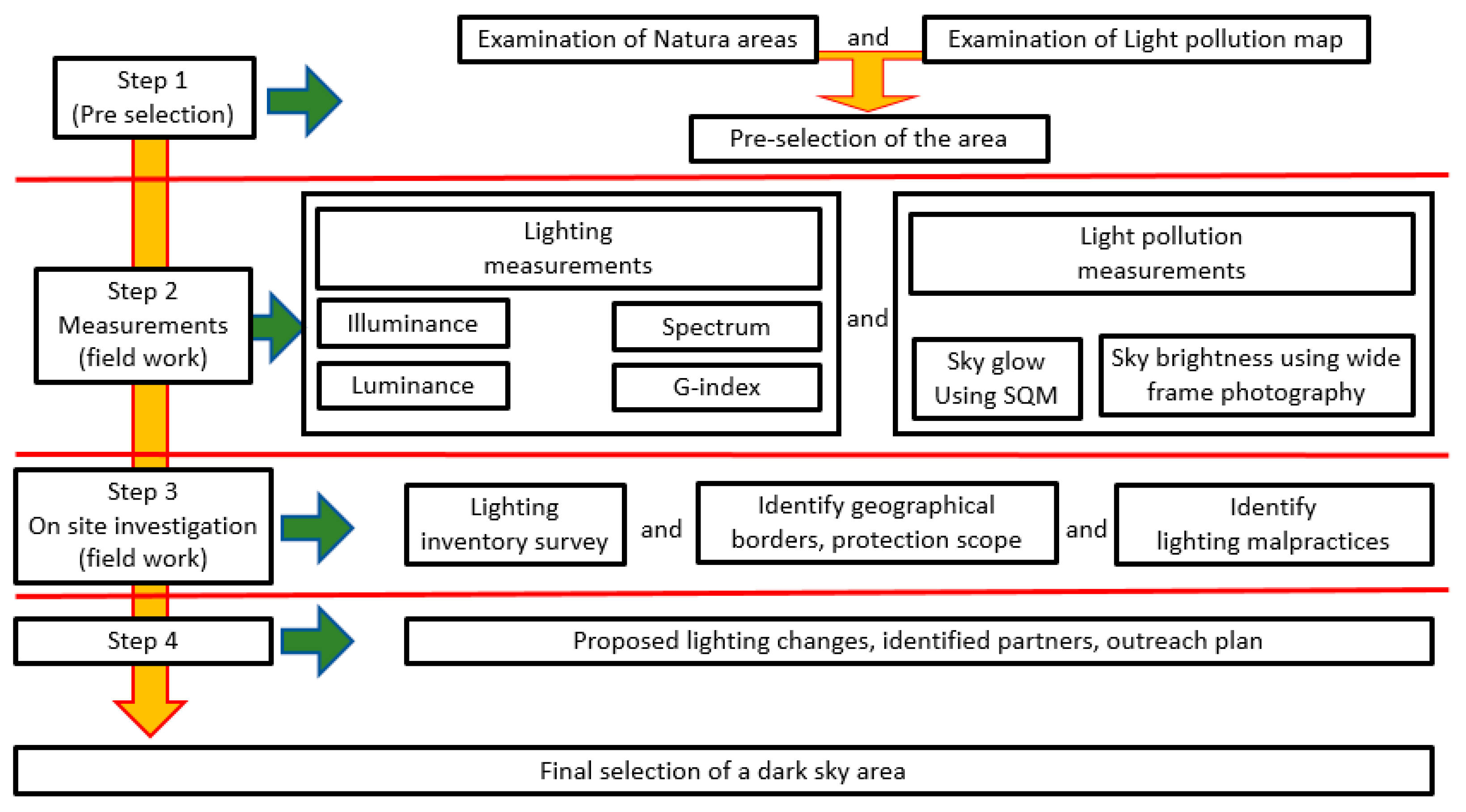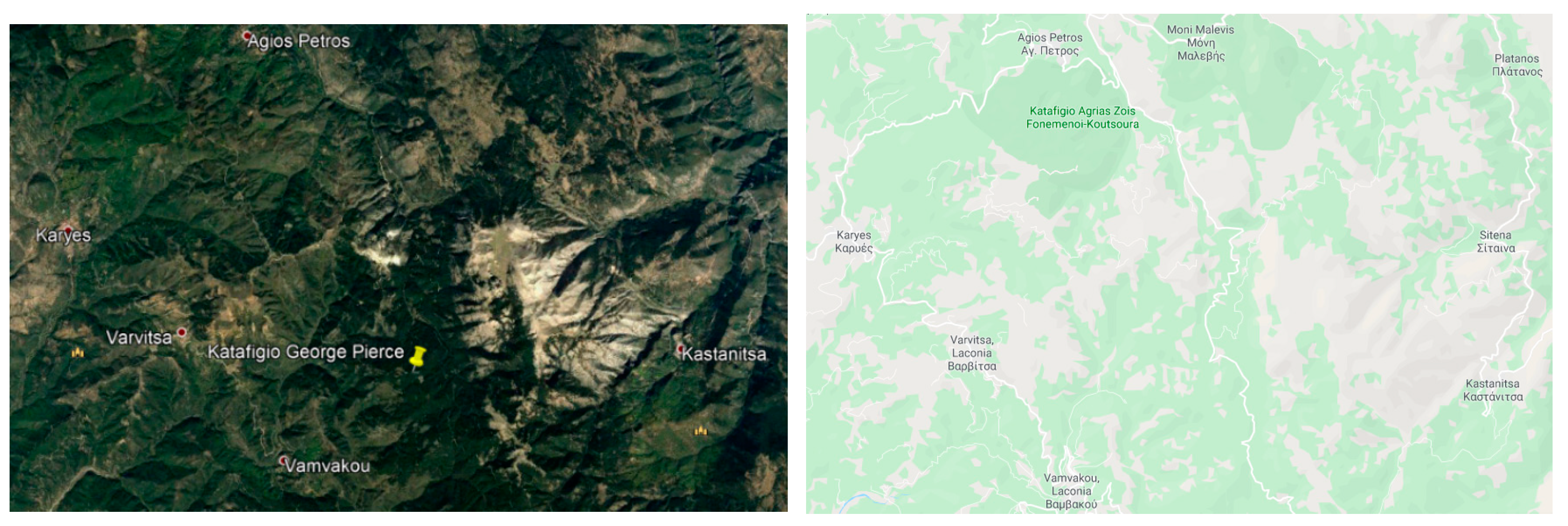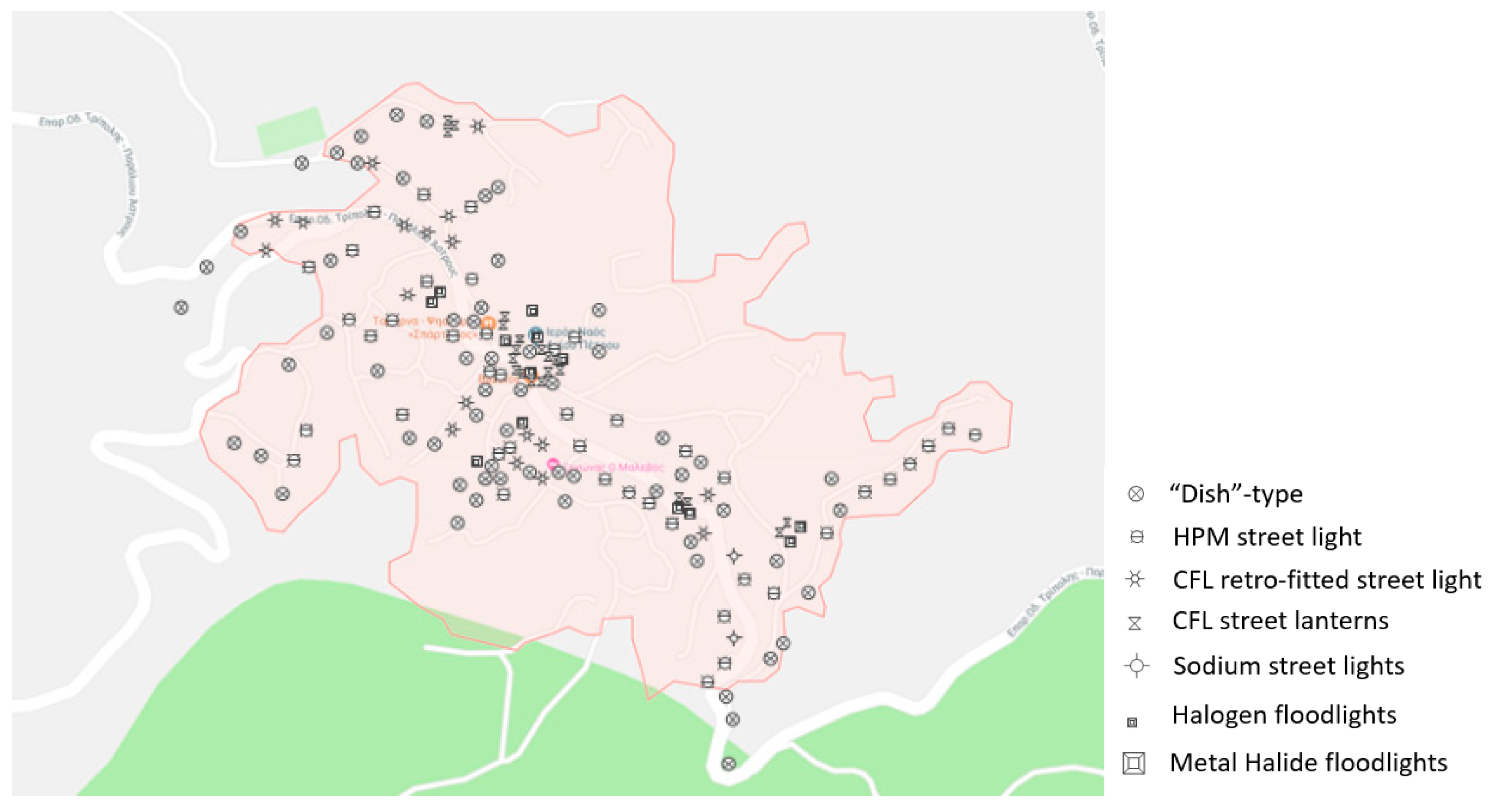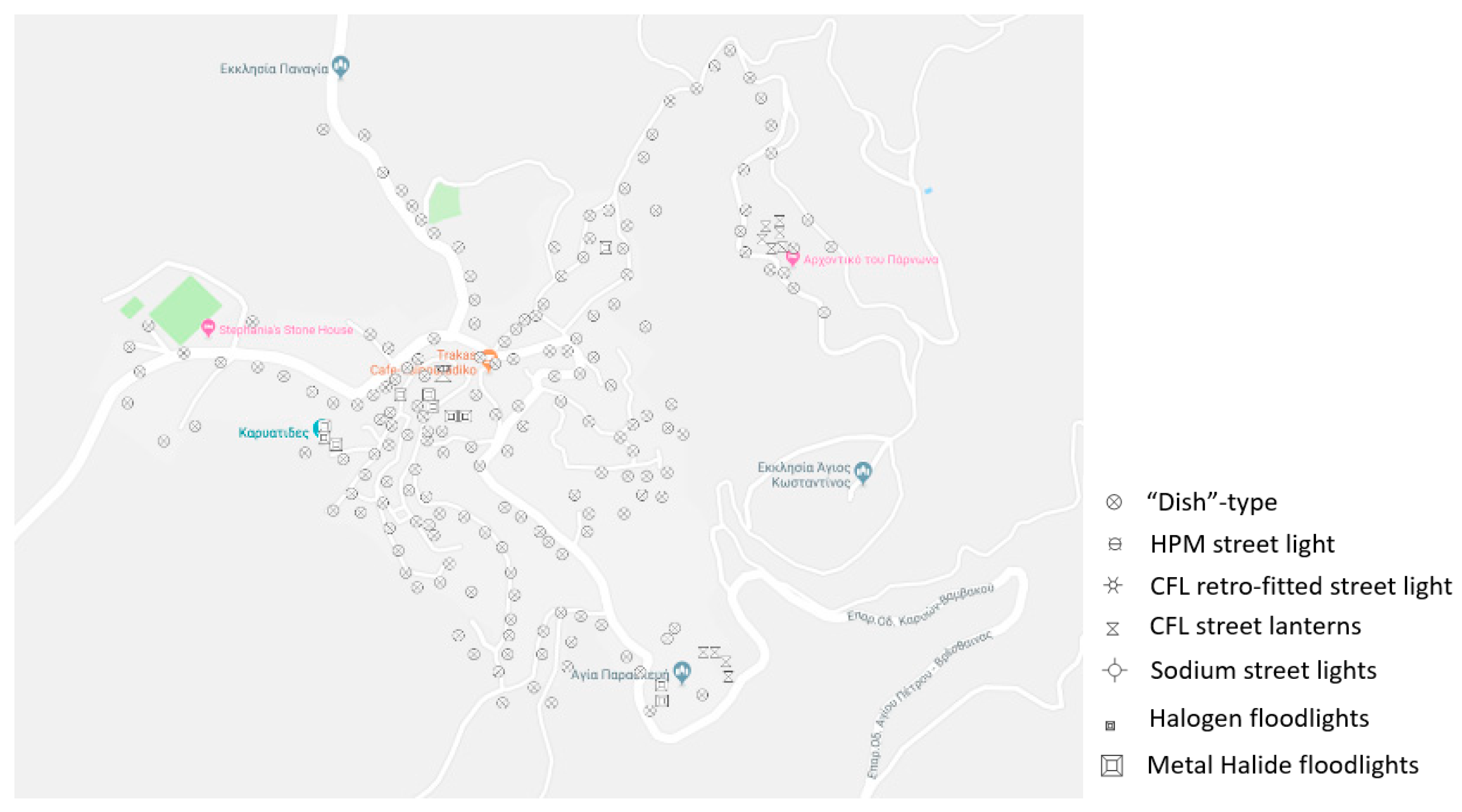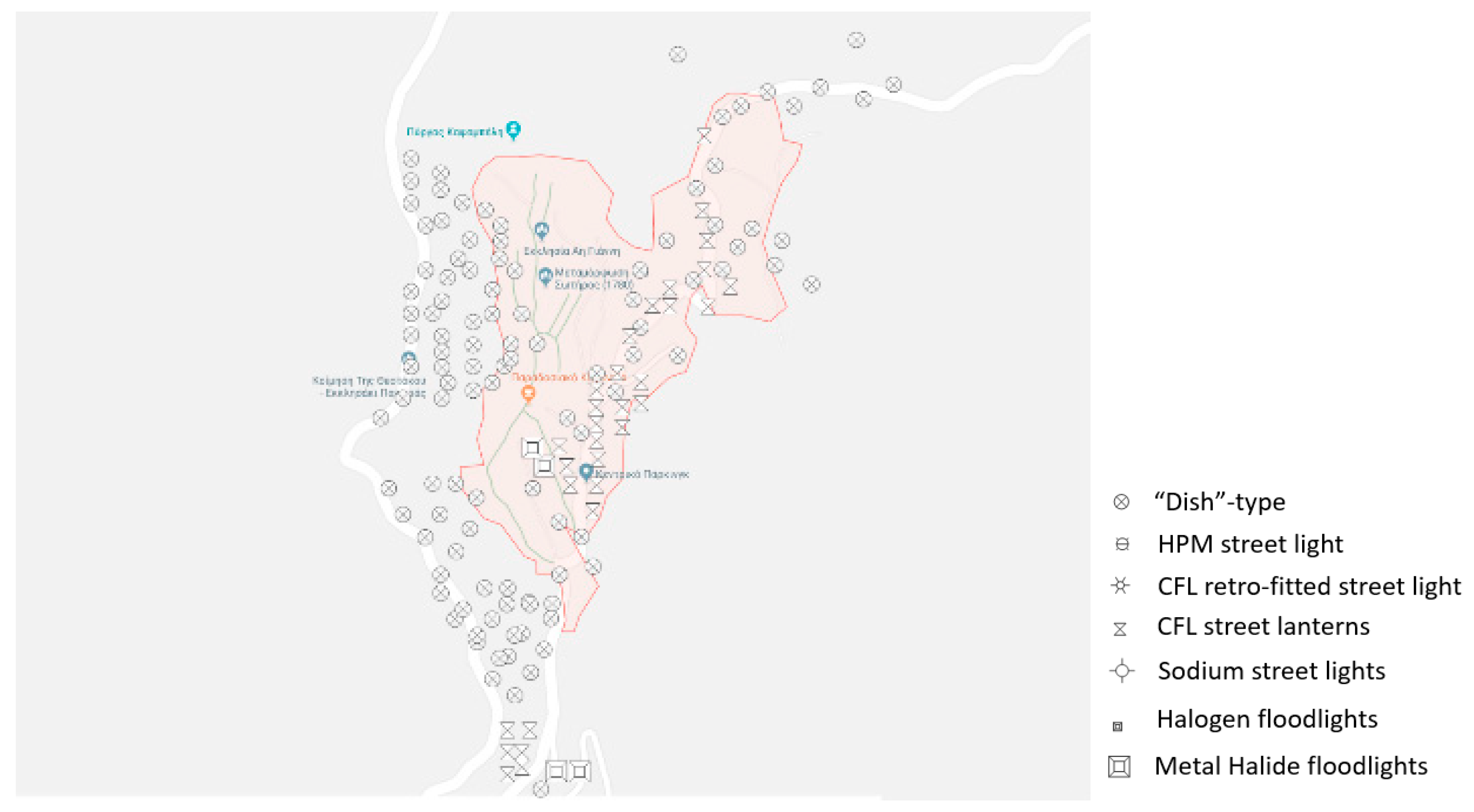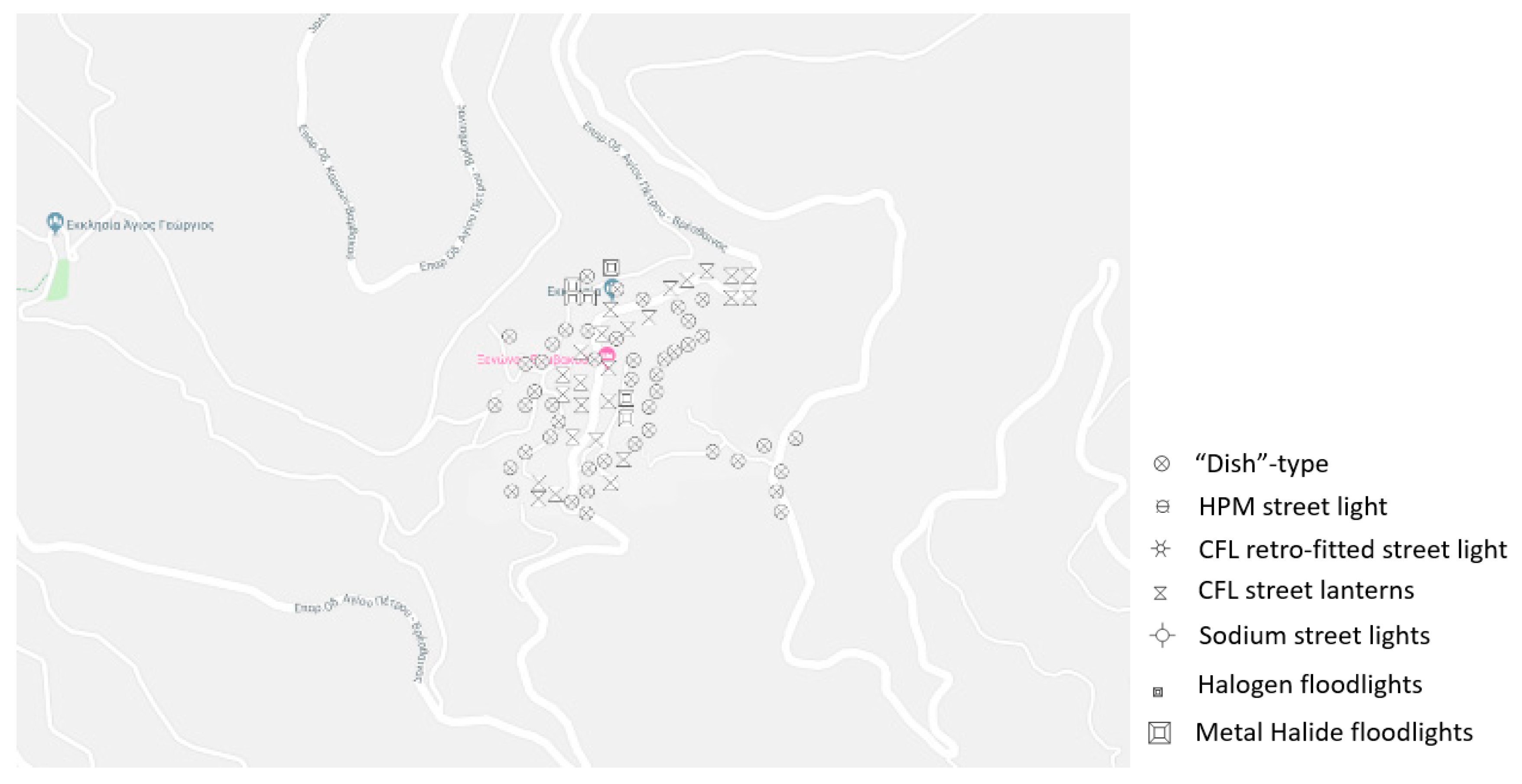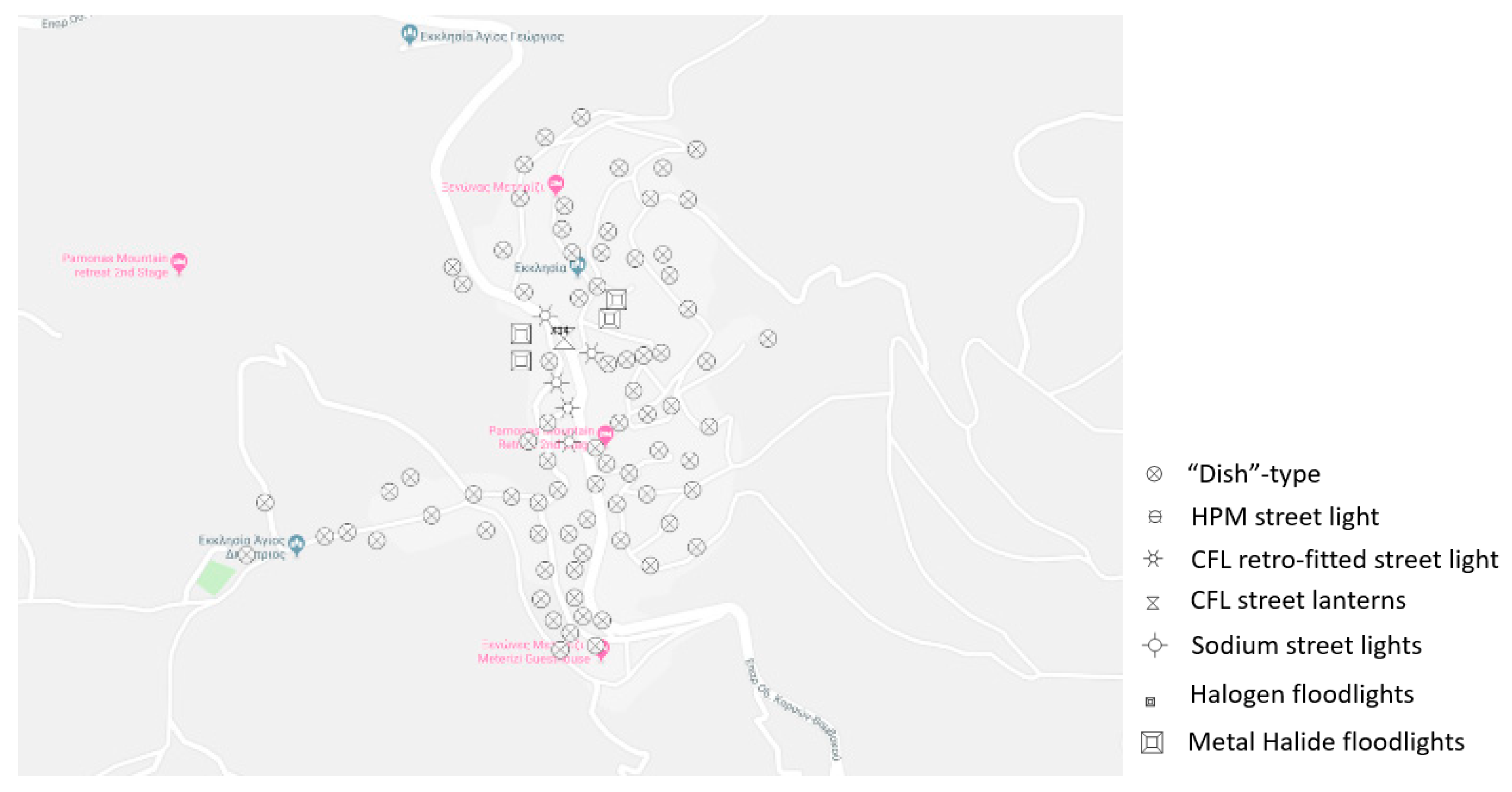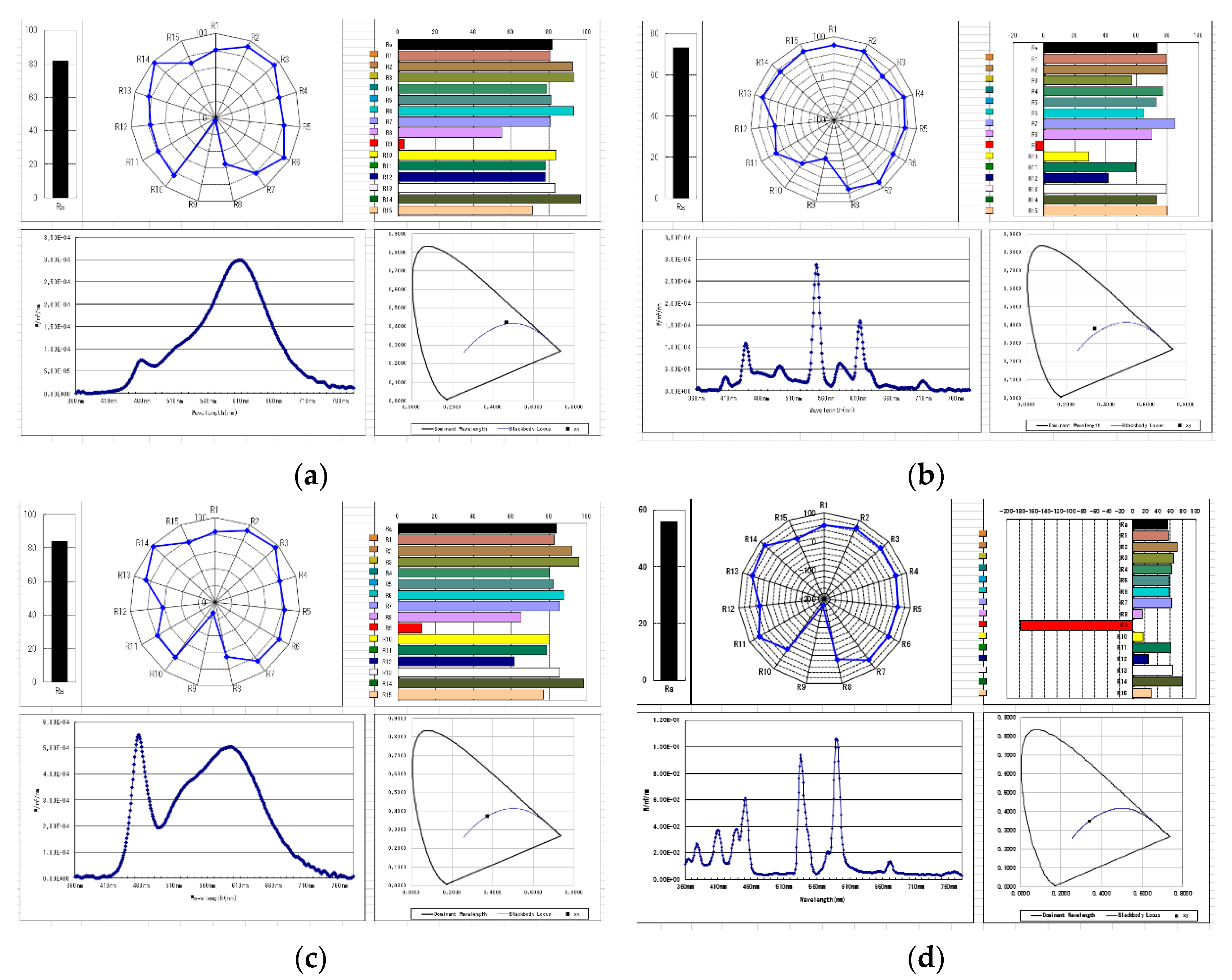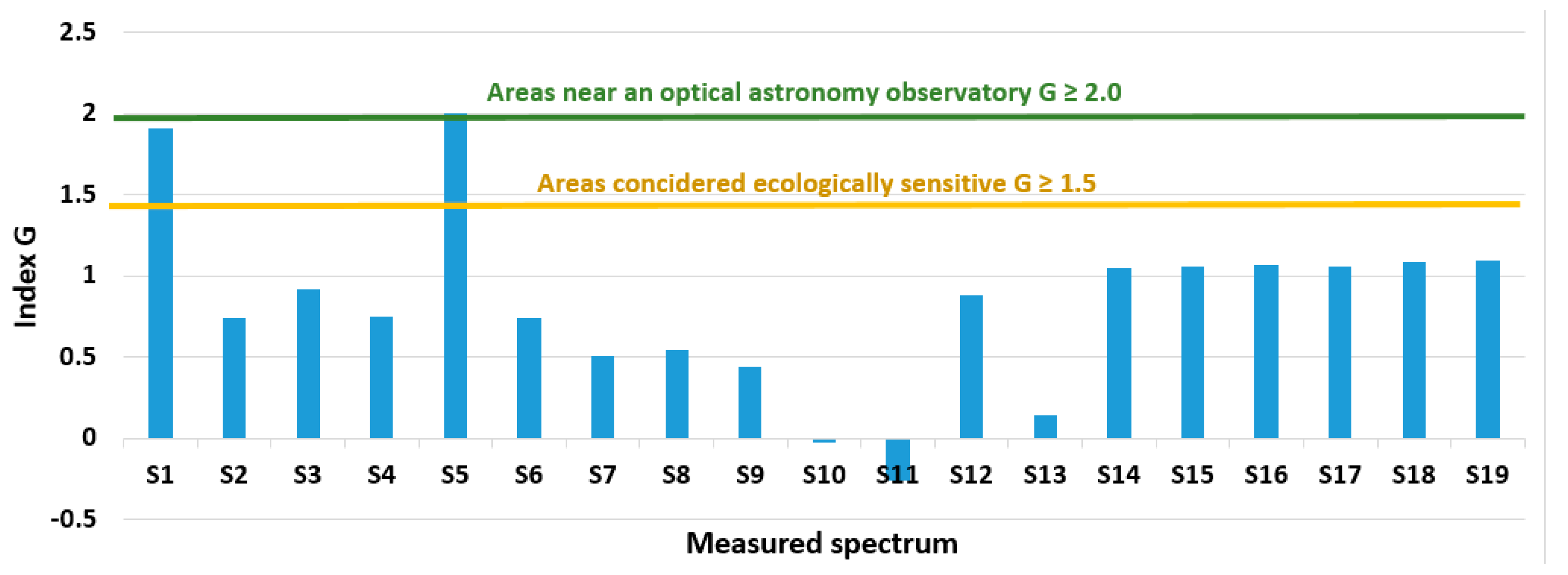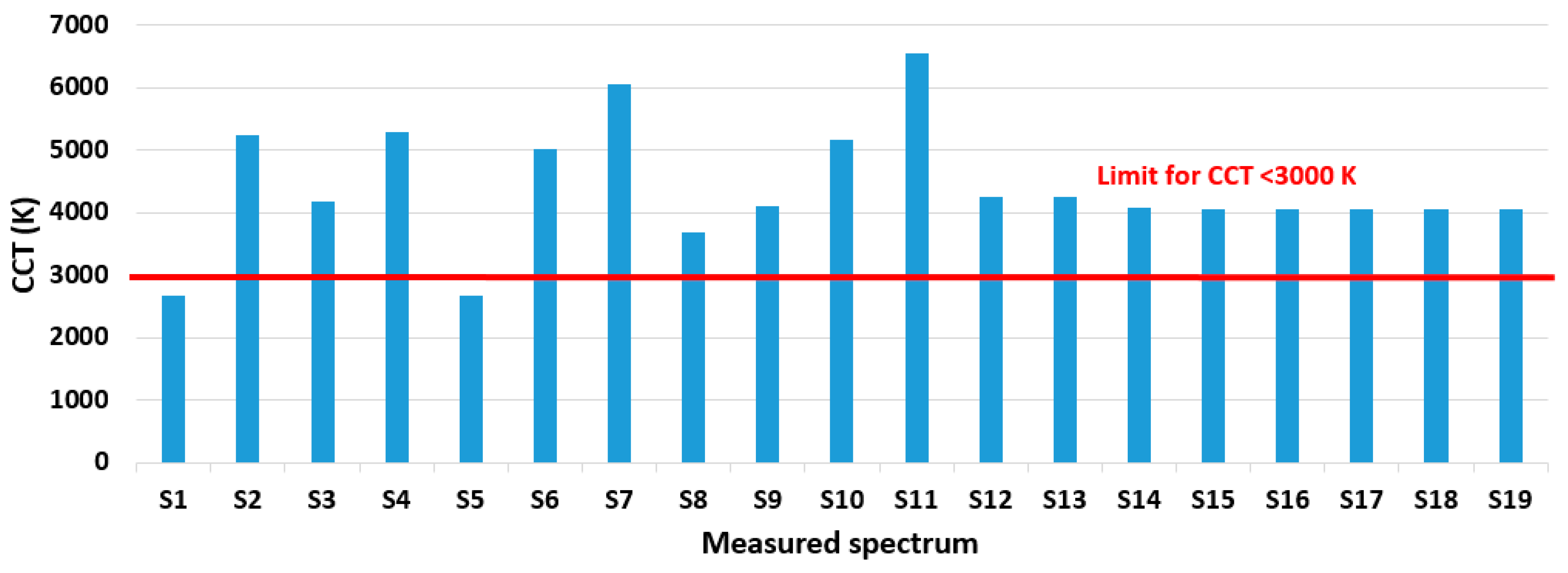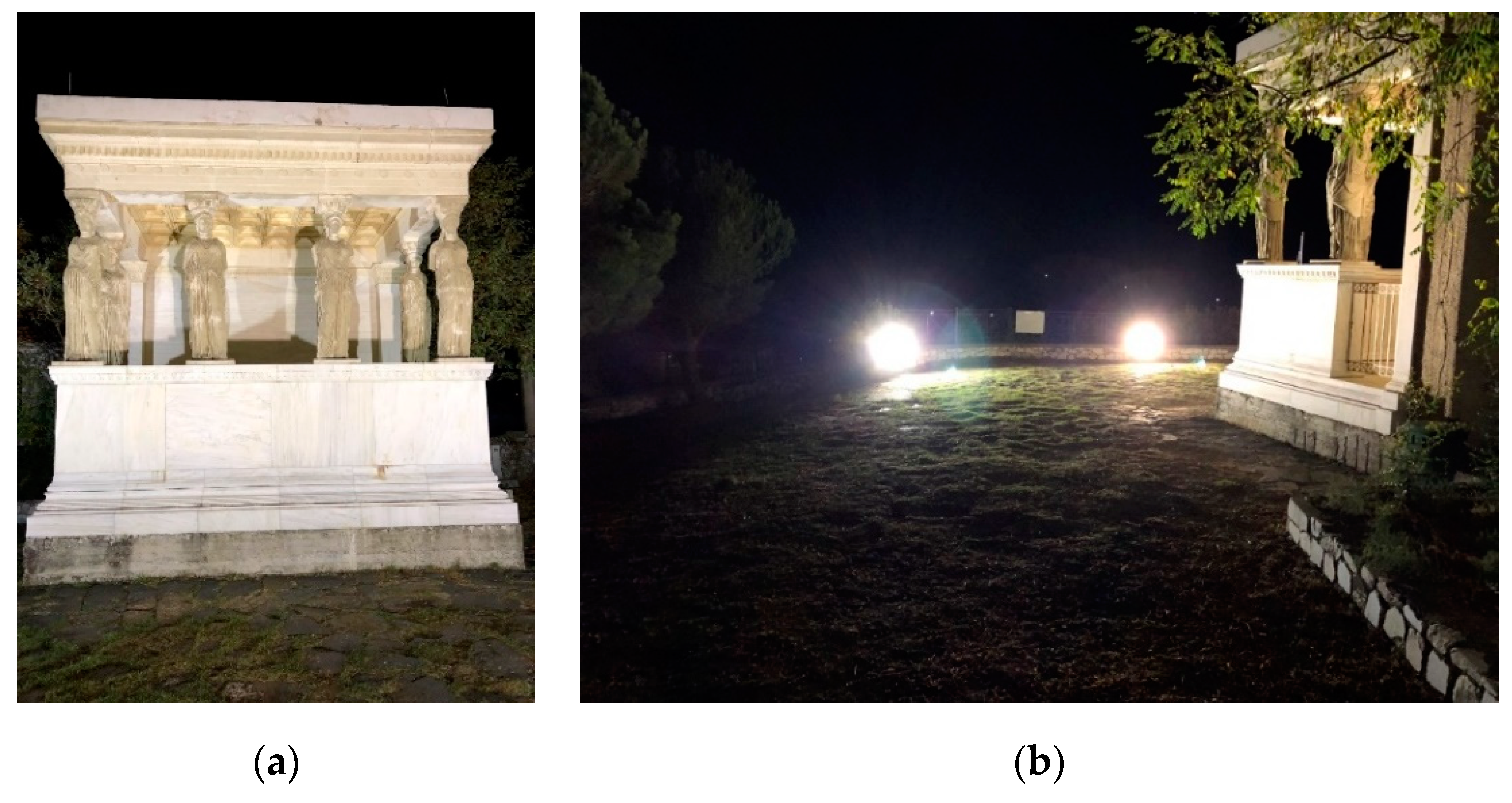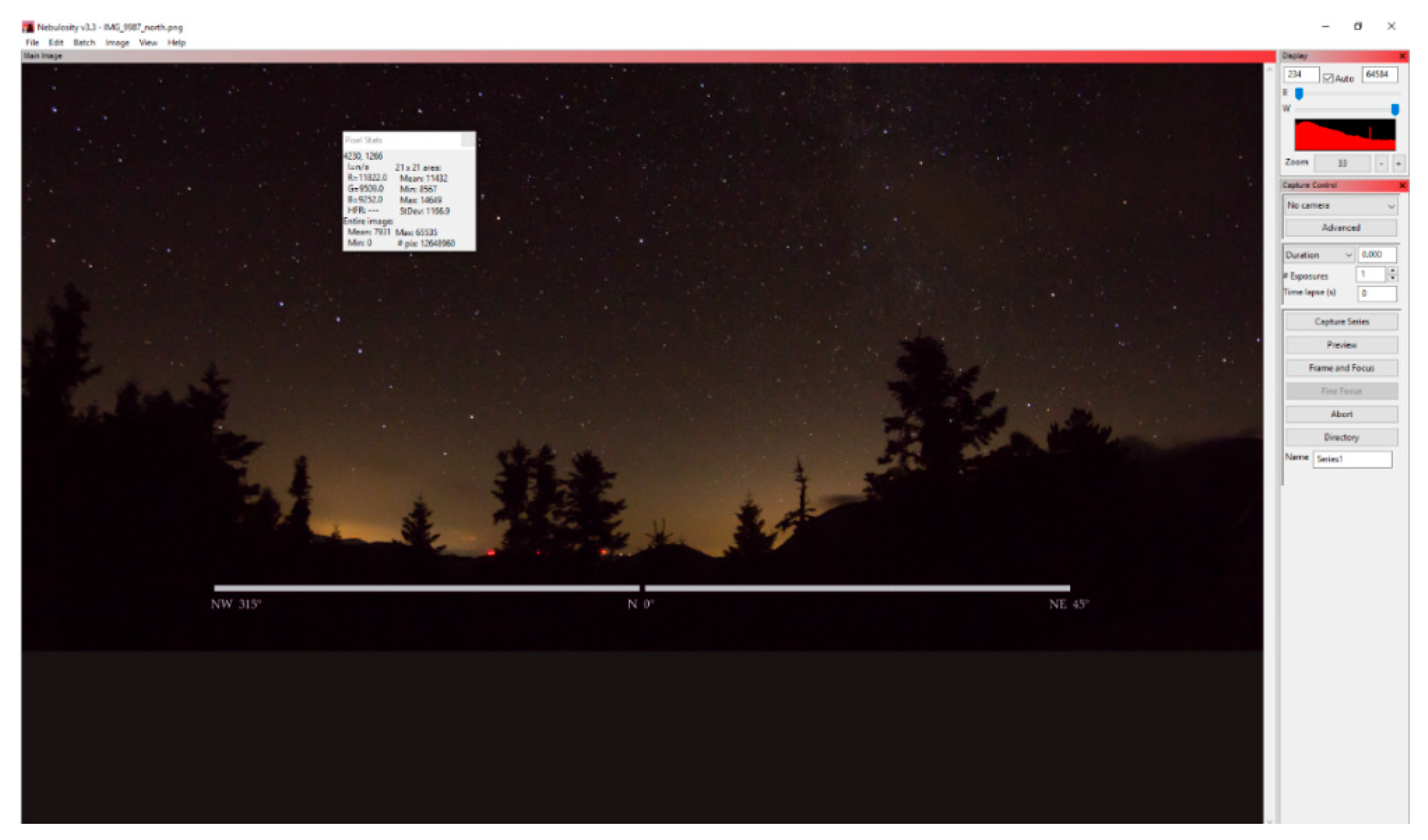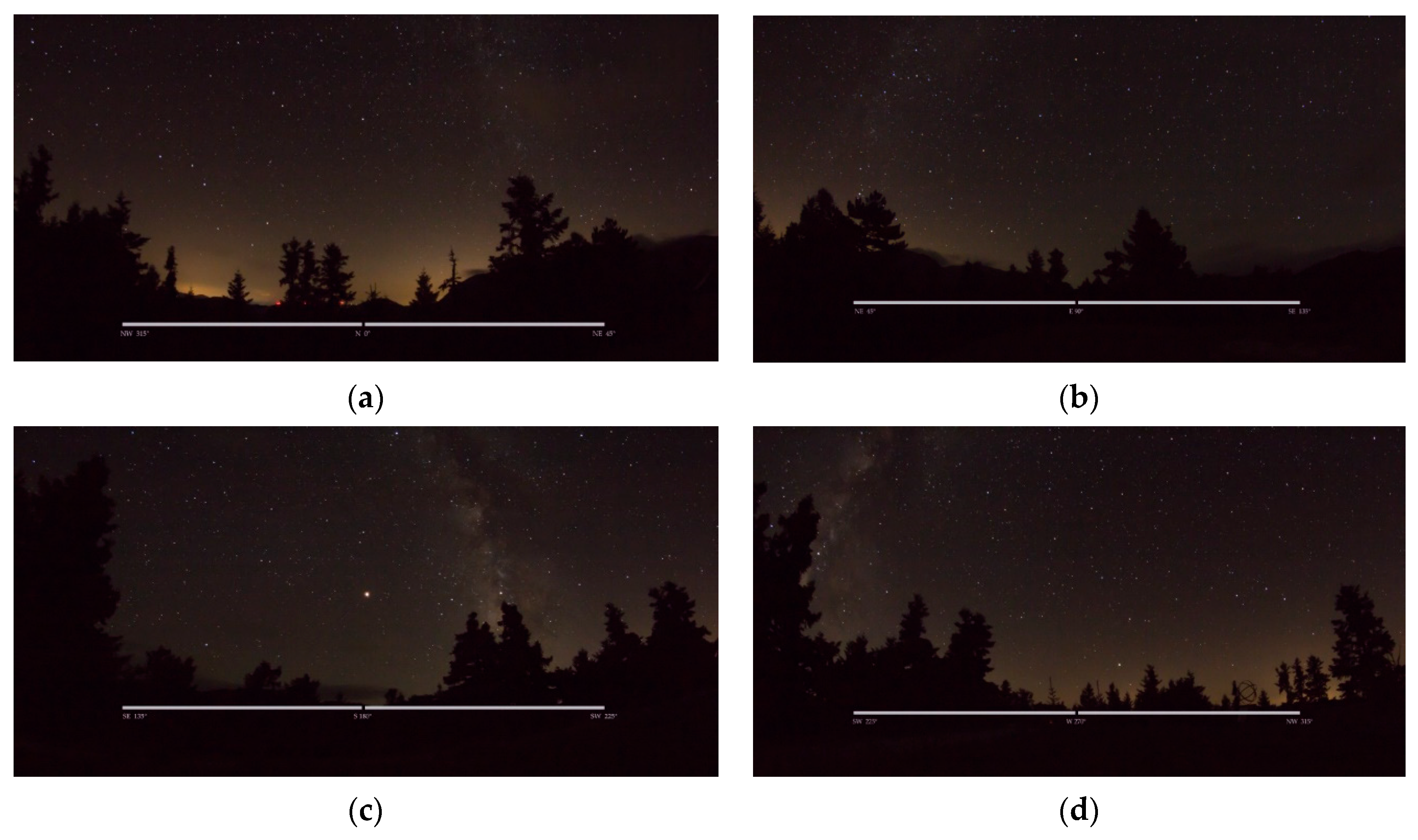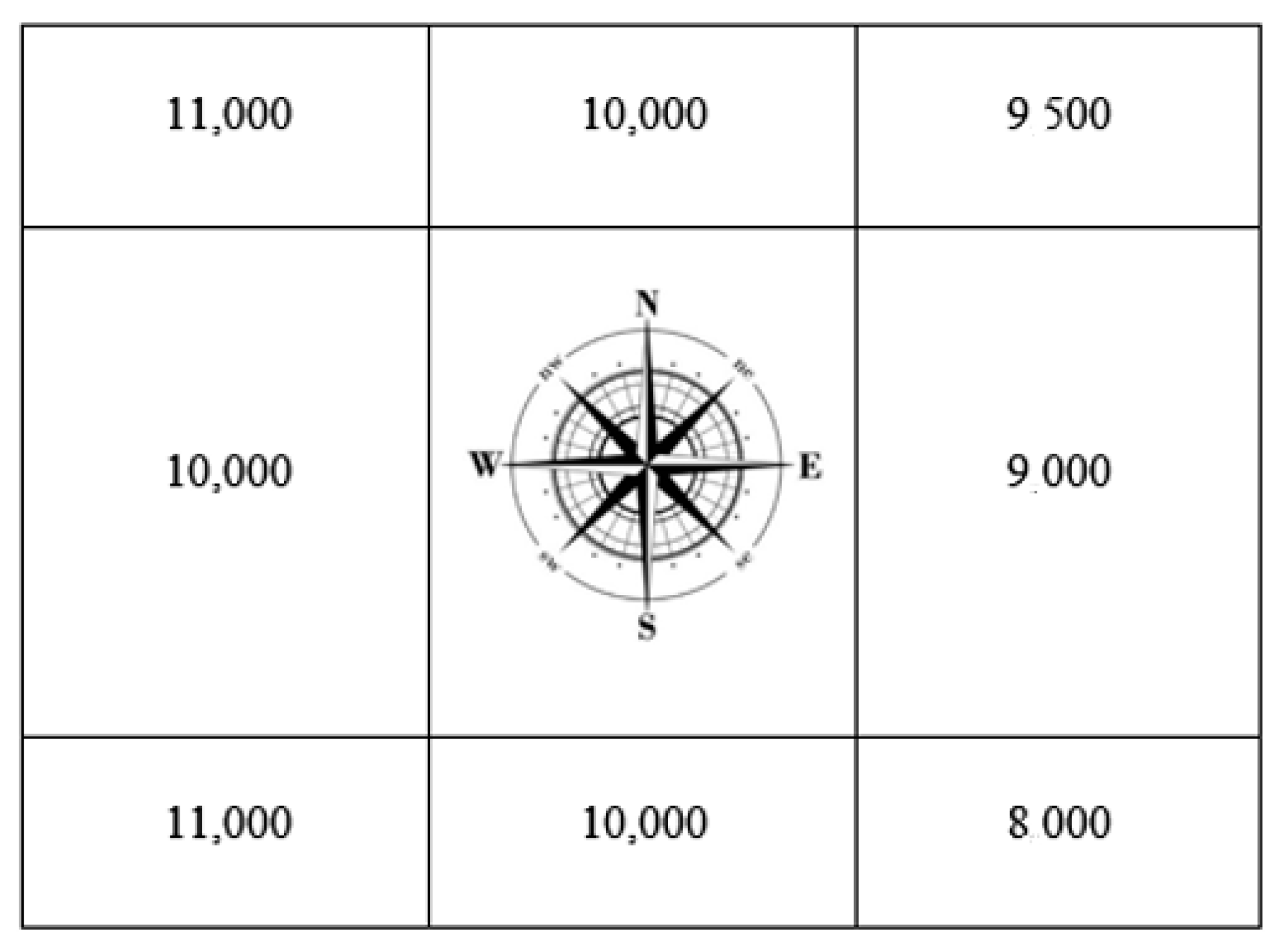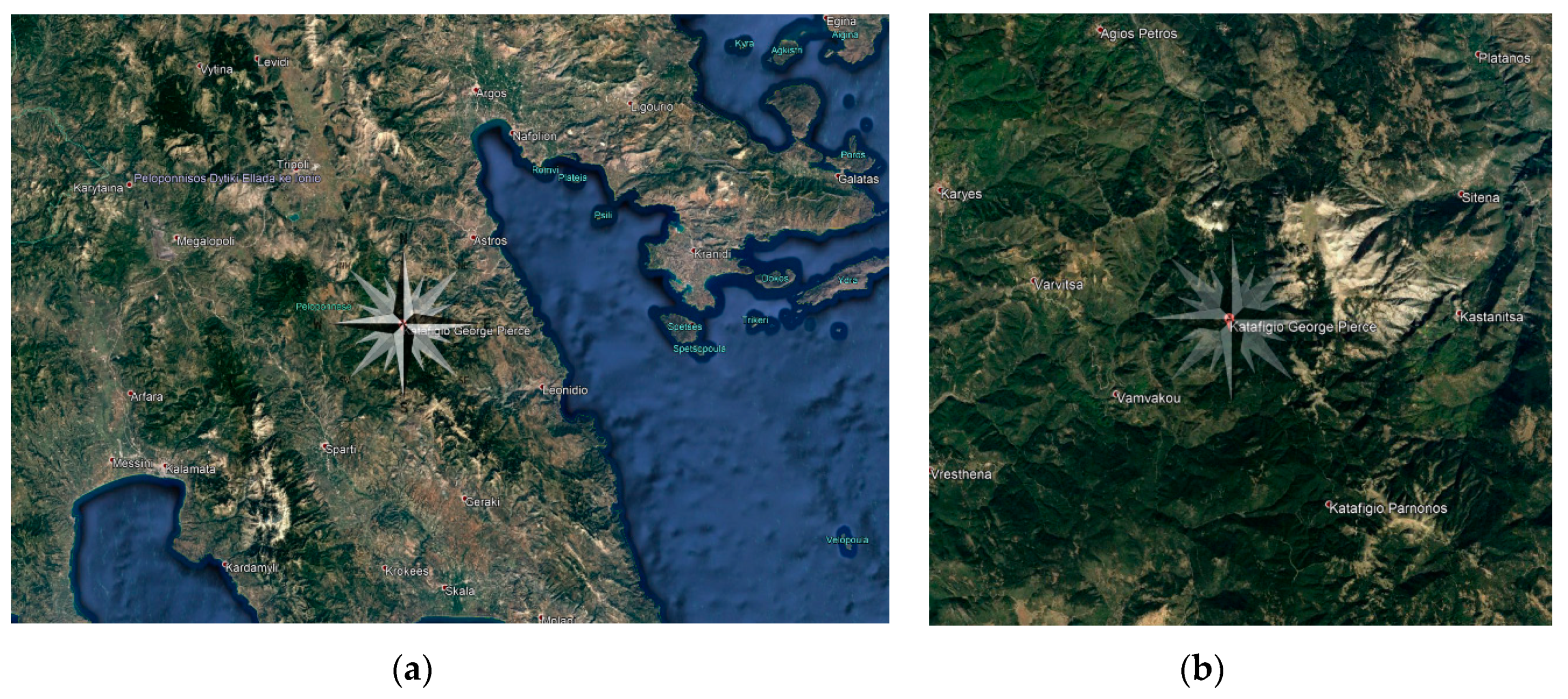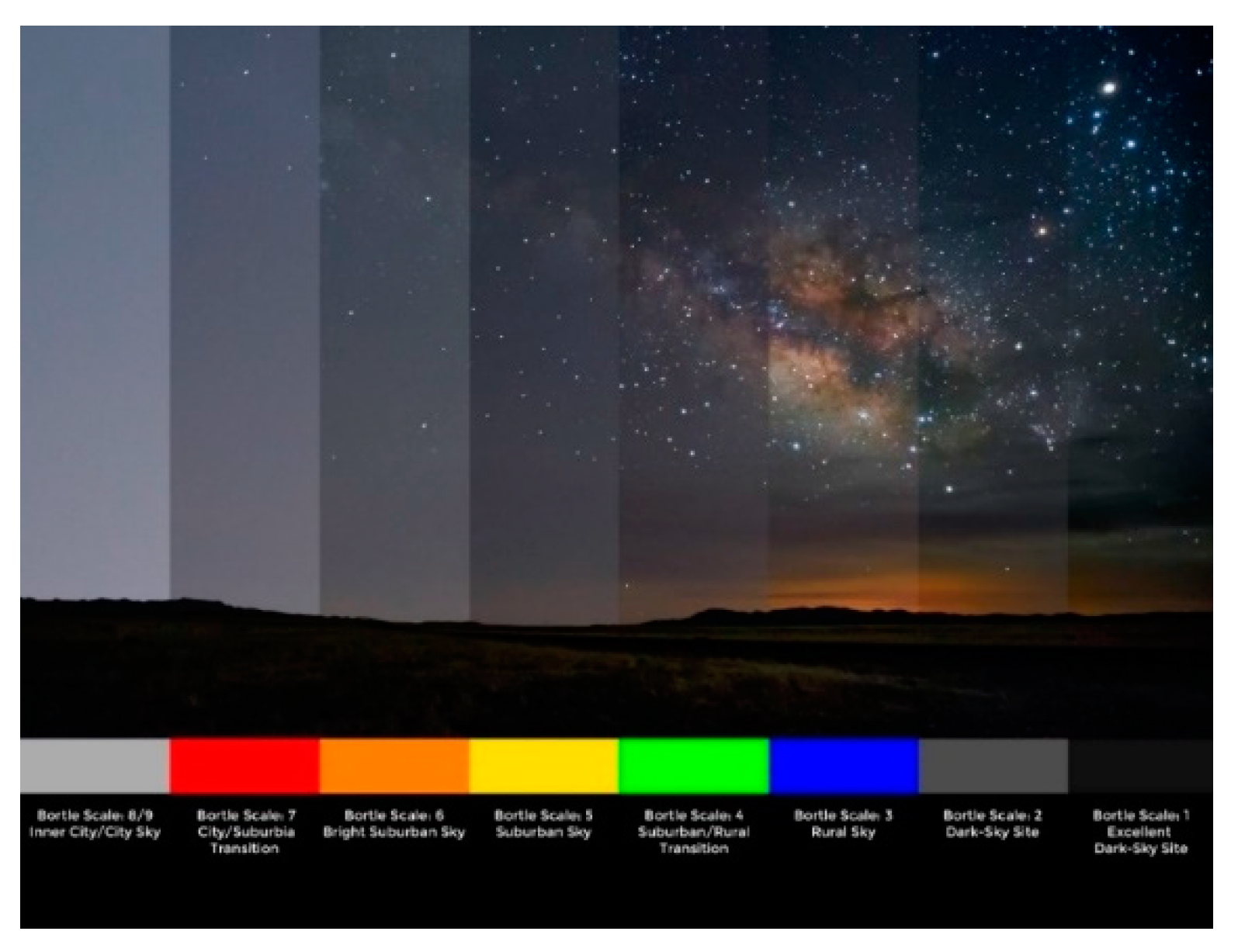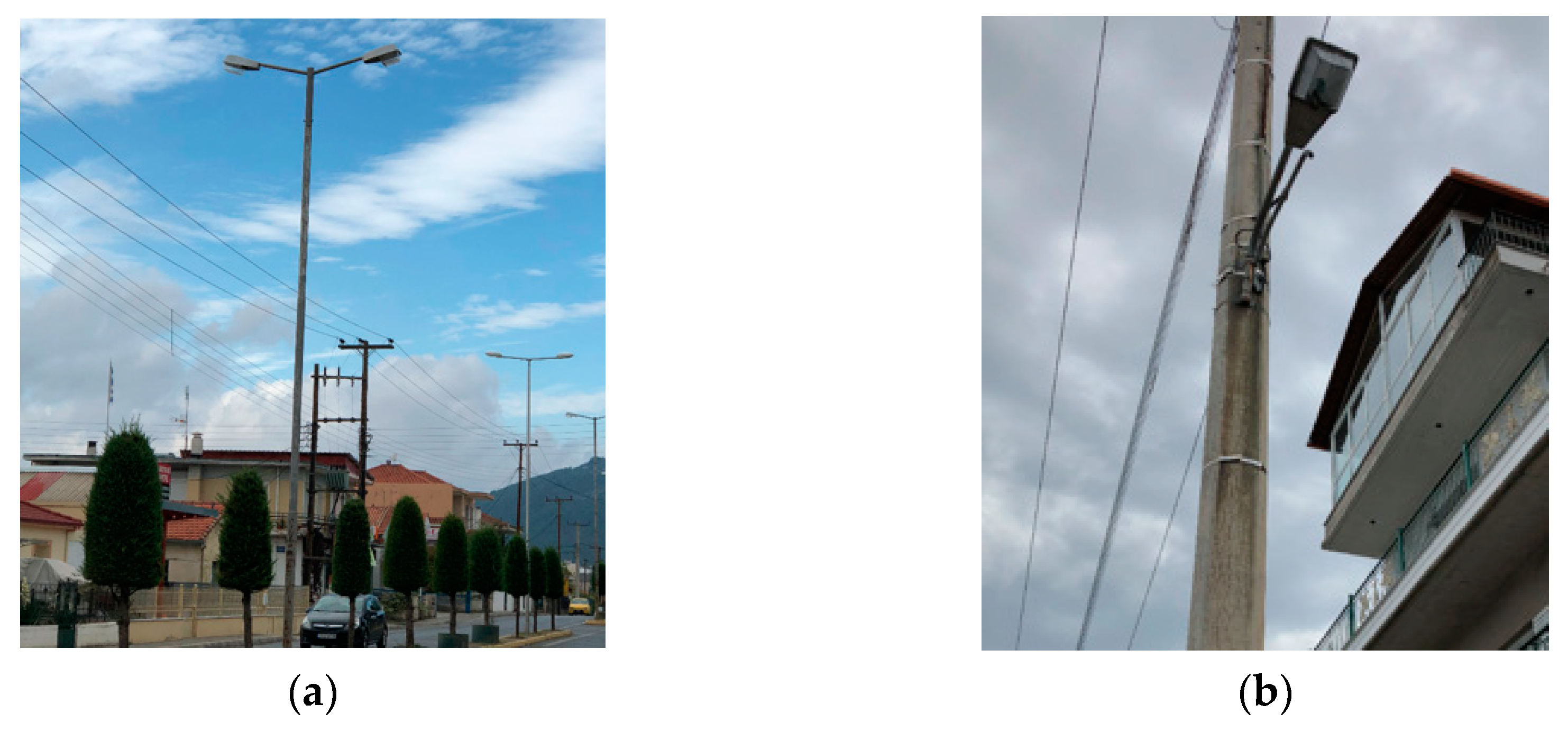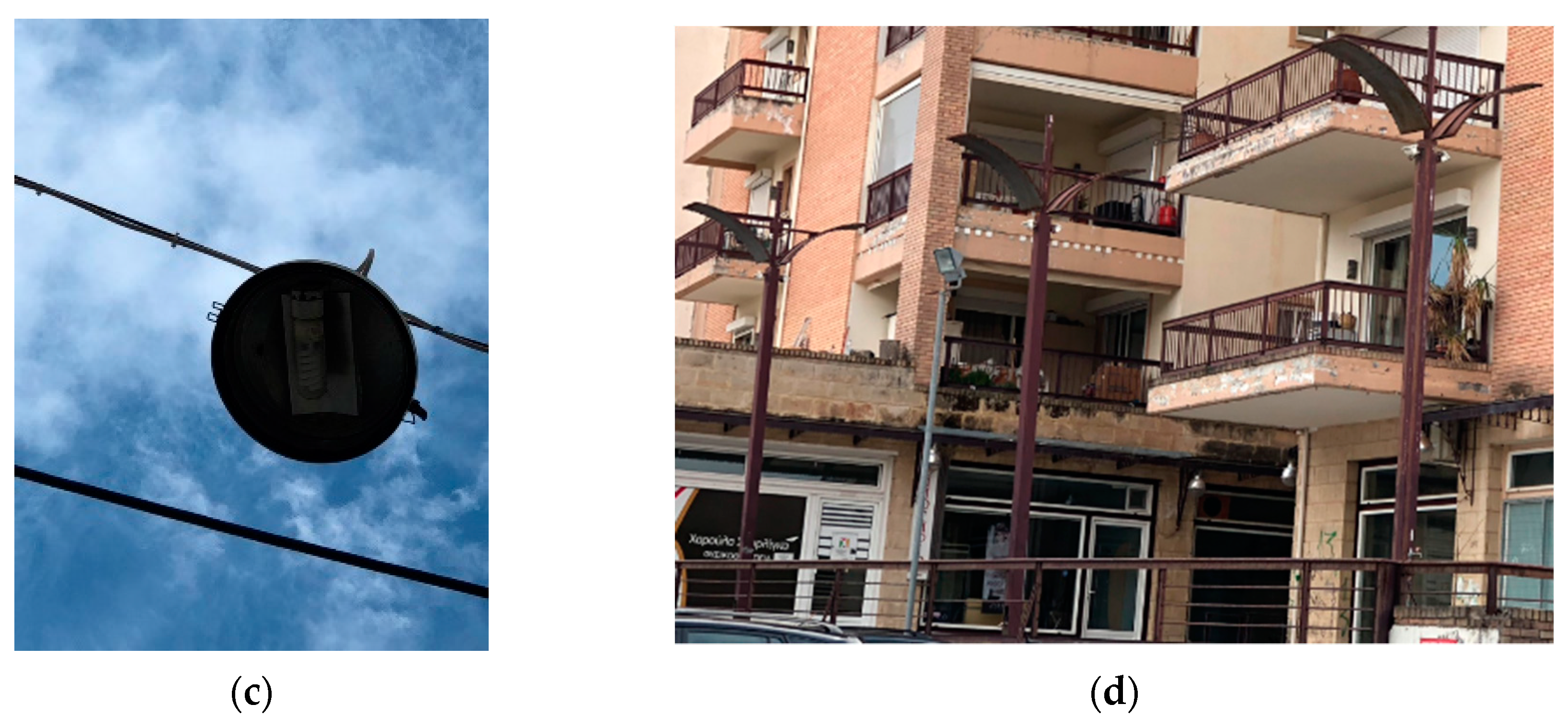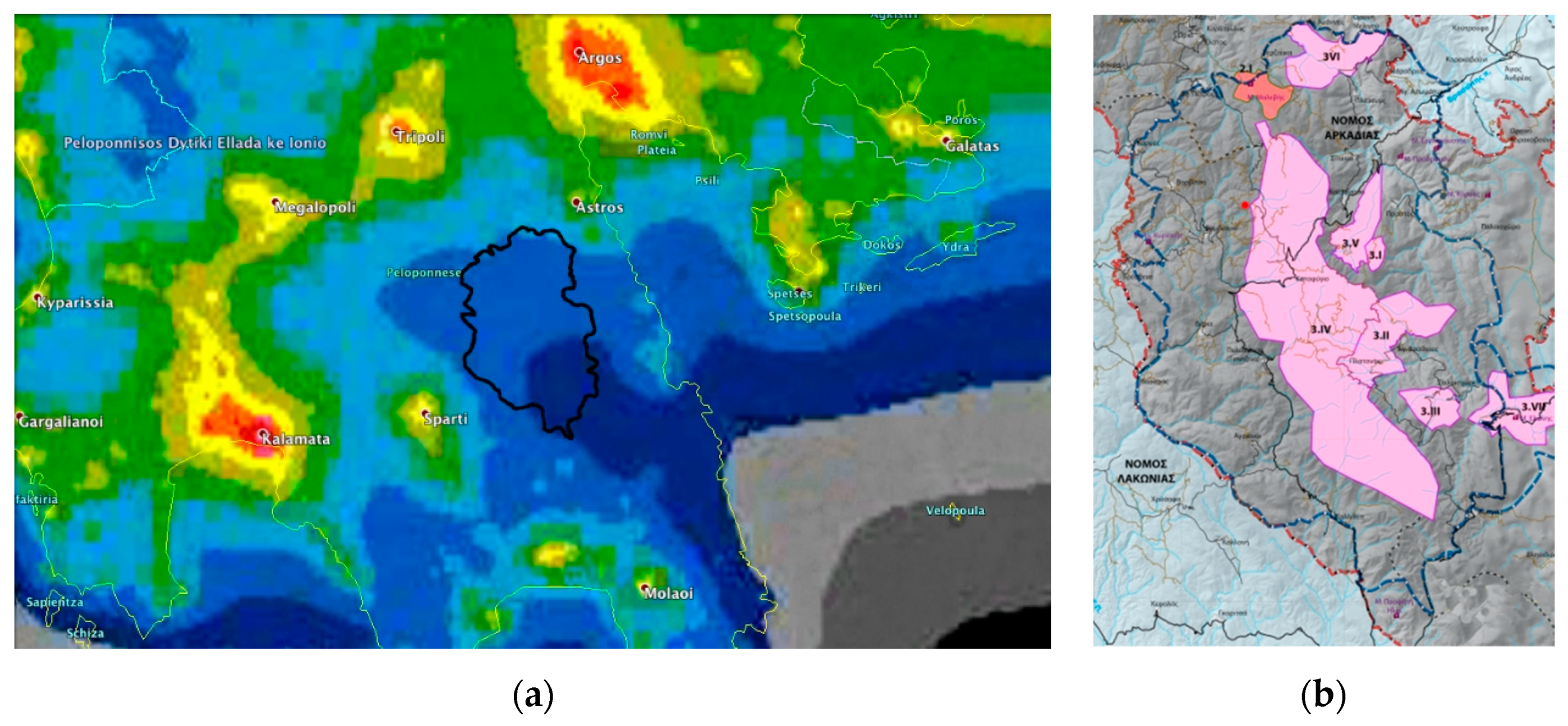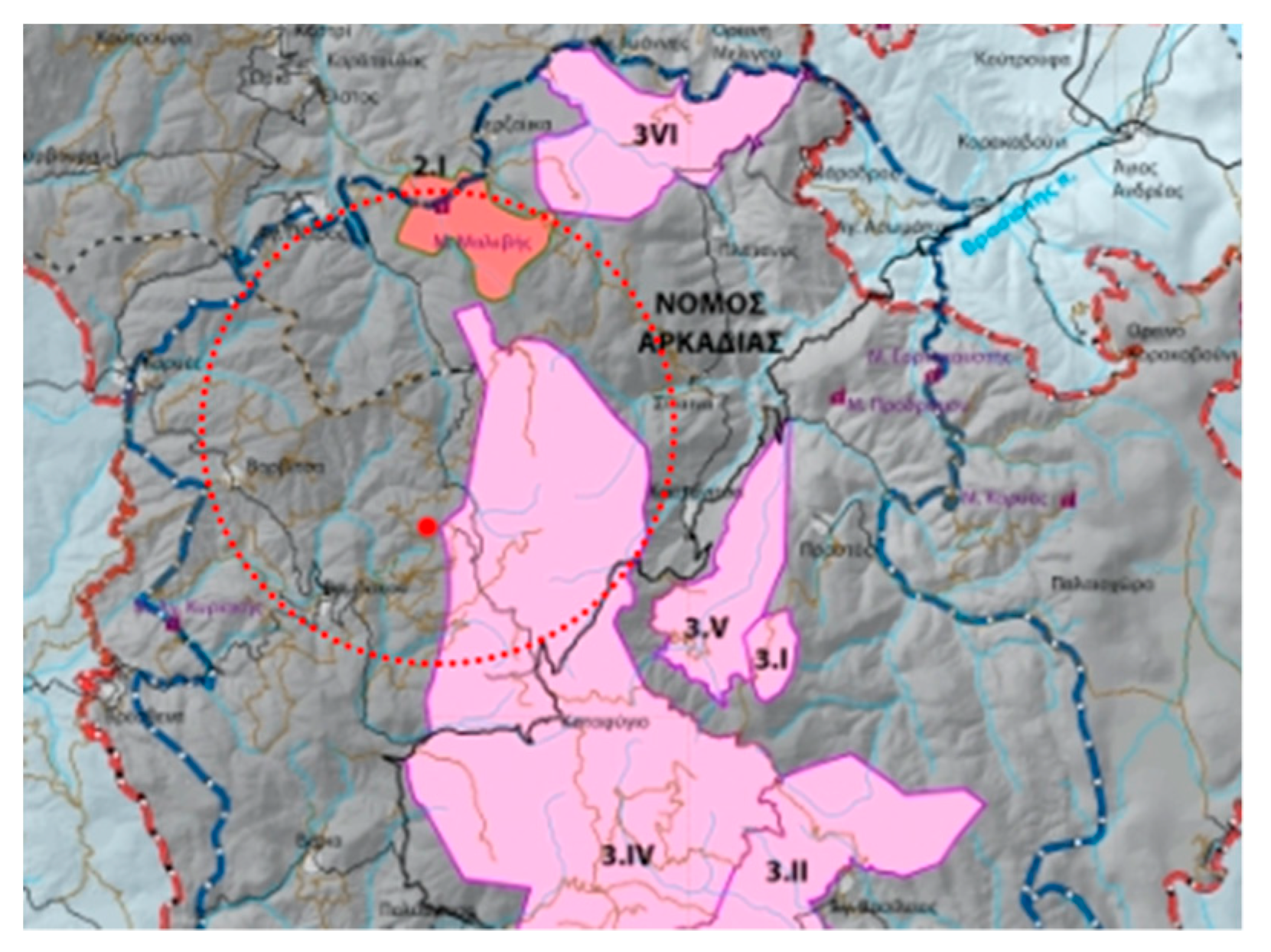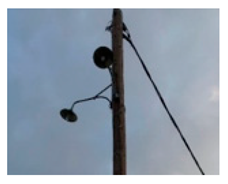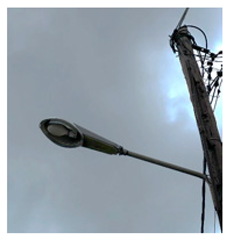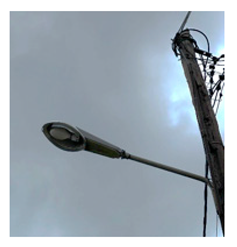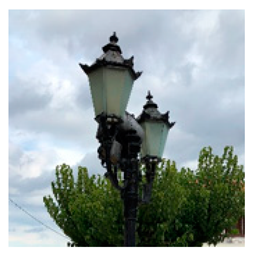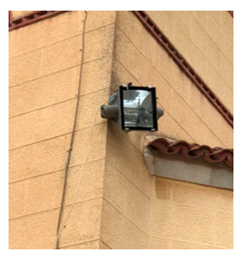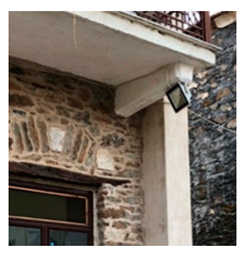1. Introduction
In recent years there has been a strong effort for making lighting design [
1,
2,
3,
4] and corresponding lighting systems [
5,
6,
7,
8] sustainable and environmentally friendly [
9] either by selecting efficient luminaires [
10,
11], lighting controls [
12,
13,
14,
15], or embodying more efficient lighting design [
16,
17,
18] or daylight [
19,
20,
21,
22,
23]. The importance of avoiding light pollution (LP) has gained interest in technical reports [
24,
25] and expert discussions [
26] only in the last few years. Light pollution can be defined as the presence of excess, poorly directed, and unnecessary artificial lighting at night which in the natural environment crosses the boundary of fulfilling basic lighting needs and may become obtrusive or harmful. In its most visible form, light pollution appears as skyglow which is defined as the artificial diffuse luminance of the night sky [
27]. Light pollution also appears in the form of glare, light trespass, and over-illumination [
28]. Light pollution causes can be seen from a cultural as well as a technical aspect. Culturally, light pollution appeared as a consequence of urbanization and industrialization that took place in the 20th century [
29]. Advances in lighting and the wide availability of electricity made electrical lighting ubiquitous, improved the quality of life for households, and made people seek more and more light while a significant industry was built around lighting which involved lighting companies as well as utility companies. Lack of awareness about potential adverse effects, low electricity prices, in combination with increased use of lighting for reasons other than fulfilling basic illumination needs, led to a type of illumination race that brought more light and higher illumination levels everywhere. Technically, light pollution owes its significant expansion to lighting malpractices including luminaire shielding, aiming, and maintenance. Light pollution would not have appeared in the levels we have today if simple technical requirements were enforced early in the quick expansion of artificial lighting.
Light pollution is most often considered to originate in the late 1960s. Before that, although the potentially harmful effects of artificial lighting were known since the beginning of the 20th century, the amount of exterior lighting did not account for a significant threat in all but a handful of cities. Increased urbanization combined with low electricity prices led to the continuous increase of outdoor lighting. In the first few decades since then, until the 1980s, light pollution did not break out as a significant problem. In the 1980s light pollution started to be recognized as a problem due to the increasing disturbance of astronomical observatories. It was at this time that efforts to counteract it first started. Light pollution continued to increase steadily until recent years when discoveries of its effect on human health gave it wider news coverage and led to its increased perception as a complex problem. Currently, the most important challenge regarding light pollution is the introduction of light-emitting diode (LED) lighting and its impact on light pollution due to the cooler spectral characteristics of typical LEDs. The most prominent international effort to counteract light pollution is that conducted by the International Dark-Sky Association (IDA) [
30]. Since its establishment in 1988, the IDA has led the effort around the world to promote light pollution awareness, lighting ordinances, and specific area protection. One of the most prominent efforts of the IDA has been the international Dark-Sky Places program [
31]. This program recognizes protected areas as dark sky places based on criteria such as their importance for astronomy or the ecosystems, their outreach programs and activities. The international Dark-Sky Places program was founded in 2001 and as of July 2019 there are just over 100 certified places globally. The Dark-Sky Places program has had a significant impact in placing LP on the agenda globally and has acted as a flagship example that LP can be reversible if authorities are convinced to act.
In order to protect sites of significant ecosystems, natural beauty, or astronomical interest, but also to continue its influence as a flagship example, it is important that light pollution reduction is included as a top priority of national parks, protected ecosystem areas, and astronomical observatories as well as public policy and ordinances. This will also present considerable economical gains due to the decrease of energy waste that light pollution brings as well as the reversal of human and animal health impacts that have been revealed in recent years [
32,
33,
34,
35]. Light pollution levels can be determined by the night sky brightness and there are several methods for the corresponding measurements [
36]. There are several types of measuring equipment, from a typical sky quality meter (SQM) [
37] to new types of photometers [
38,
39]. Except for SQM measurements, citizens’ observations could be valuable [
40] as long as there is a consistence to their observations [
41]. The scope of this paper is to identify the most appropriate area in Greece to be nominated as a dark sky place and perform a preliminary study on its suitability. A methodology is presented and applied to the region of the mount Parnon area in the Peloponnese. This methodology includes a lighting inventory which was created by surveying luminaires, sources intensity, type and spectrum in the villages surrounding the astronomical site as well as light pollution measurements [
36,
42,
43,
44] and assessment of socio-economic and environmental factors.
2. Materials and Methods
2.1. Overview
In
Figure 1 we present the overview of the methodology that was followed in order to select and assess the area. In order to plan for a protected area, it is necessary to survey as many parameters as possible regarding geography, the condition of the night sky as well as the lighting installations of the area. The most important parameters that were surveyed and their results are as follows:
Lighting inventory survey
Intensity and spectrum characteristics
Light pollution assessment
Assessment of various socio-economic and environmental factors
The lighting inventory survey included the following parameters:
Photographs of the most common luminaires
Light intensity measurements
Light source type
Geometrical characteristics of the lighting installations (height of luminaires, inclination, etc.)
Brief description of light distribution
2.2. Selection of the Protected Areas
In the early 1990s, the European Union (EU) habitats directive 92/43 [
45] aimed to confront the increasing threat of extinction for many species of flora and fauna. It was later incorporated into Greece’s national legislation by the Joint Ministerial Decision 33318/3028/1998. The main aim of the Directive is to promote the maintenance or restoration of biodiversity, taking account of economic, social, cultural, and regional requirements. As a main part of the conservation effort, a European ecological network of protected sites was created and named Natura 2000. This protection status had no association with light pollution at the time. Greece included as part of the network 241 sites of community importance (SCI) according to the EU Directive 92/43 and declared 202 special protected areas (SPAs) according to EU Directive 79/409. A map of the areas of Greece that form part of the Natura 2000 network appears in
Figure 2a [
46]. Green areas represent areas of protected status. It is notable that a large percentage of the land in Greece is under protection which makes Greece an important protection zone.
To perform a general overview of light pollution in Greece, the data from the 2016 light pollution atlas were used [
47]. The map (
Figure 2b) shows significant light pollution areas extending tens of kilometers around the two major cities (Athens, Thessaloniki) as well as significant light pollution areas around other large cities (Patra, Volos, Larisa, etc.). It is also evident that light pollution follows the path of major highways (Athens–Lamia, Lamia–Thessaloniki, Olympia and Moreas highways). The most significant light pollution gaps identified in the map (evident by darker-blue color) were found in the following areas:
Parts of central and southern Peloponnese around the mountains Helmos and Parnon
Parts of central Greece around Agrafa mountains
Parts of Western Macedonia around Grammos mountain.
Parts of Southern Crete
It is evident that dark skies in Greece are mostly found in significant mountain ranges. This is due to the fact that mountains are sparsely populated, due to the lack of major lighted roads and less light propagation in mountainous terrain.
Greece is home to a very active amateur astronomy community which has a very significant role in science outreach. The community also forms a link between the scientific community and the public. Greece has more than 20 amateur astronomy clubs, as well as individual amateur astronomers, who typically visit light pollution-free areas in order to observe using their telescopes. A limited number of these areas have been selected due to their dark skies, easy access, and natural beauty, as sites of the annual amateur astronomy gathering. In total, 12 annual amateur astronomy gatherings have been organized as of 2018 in various places, but two sites stand out because they have been repeatedly selected for their dark skies:
A place of both significant natural and astronomical importance, mount Parnon was chosen as the proposed area for the first International Dark Sky Park in Greece.
2.3. Case Studies of Mount Parnon Area
The observing site at mount Parnon is located next to the “George Pierce” alpine refuge of Parnon at an altitude of 1420 m and located within a Natura 2000 protected area. It was discovered by amateur astronomers of Athens in the 1990s and has been an unofficial place for amateur astronomy gatherings for the last two decades. In 2010, the site became the location of the 4th Greek amateur astronomy gathering organized by the Sparta Astronomical Union “Dioskouroi” and Astronomical Society of Patras “Orion”. This gathering led the site as well as the annual gathering to fame all over the country. The Parnon observing site stands out for its dark skies, large and level observing ground, easy access by car and vicinity to the “George Pierce” alpine refuge. Mount Parnon is an ideal place for designating a dark sky park due to it simultaneously being a Natural 2000 protected area, one of Greece’s darkest places, and a popular astronomical observing site. The borders of the officially designated protected area are shown in
Figure 3, along with the area with astronomical activities (pin in
Figure 3). The protected area is managed by the Management Body of Mount Parnon and Moustos Wetland. The management body manages a wide area of disconnected and varied sub-areas, with various statuses of protection. A detailed map of the protected areas appears in
Figure 4 [
49].
The protected area comprises a large number of settlements (small or medium villages), but not any major cities. The protected area extends mainly in the former prefecture of Arcadia but also in parts of the former prefecture of Laconia. These now belong to the region of Peloponnese. The municipalities found in the protected area are the municipalities of North Kynouria, South Kynouria, Tripoli, Evrotas, and Sparti. Nearby large cities include Tripoli, Sparti, and Astros. Important settlements in the area near the astronomical observation site include Agios Petros, Karyes, Kastanitsa, Vamvakou, and Varvitsa. The settlements of Agios Petros and Karyes are particularly significant tourist villages due to the natural beauty of the area as well as the nearby monastery Malevi which attracts a significant number of tourists.
3. Results
3.1. Lighting Inventory and Influence of Nearby Settlements
The location of the examined villages forms a circle (
Figure 5) with the astronomical site in the center. All these villages present significant activity as they are popular mountain tourist destinations and also centers of high-altitude agriculture.
Lighting inventory in the nearby area consists mainly of old, unshielded, or semi-shielded luminaires either in their original form using older technology lamps (high pressure mercury (HPM) lamps) or retro-fitted with LED lamps or compact fluorescent lamps (CFL). A large number of luminaires are damaged; they are either non-functional or with significant damage such as broken protective covers, missing sanded glasses, etc. This significantly impacts their operation as luminaires and distribution of light as well as their durability since the manufacturer’s Ingress Protection Marking (IP rating) is no longer valid. This leads to light sources and luminaire internals being exposed to exterior conditions and frequent lamp replacement, typically with low-cost and low-quality parts. A large variety of luminaire–lamp combinations were observed, leading to the conclusion that maintenance was carried out in an opportunistic way with no particular plan but rather a day-by-day approach. The most common public luminaire types in the area appear in
Table 1.
Agios Petros is the closest village to the astronomical site and mostly serves as a local shopping and entertainment center. Lighting in Agios Petros is predominantly of two types—the dish-type luminaire (L1) and mercury streetlights (L2)—while a number of streetlights have been retrofitted with CFL lamps. Details on the lighting inventory of Agios Petros are given in
Figure 6 and
Table 2. In Karyes, mostly “dish”-type luminaires and lanterns are installed (
Figure 7).
Figure 8,
Figure 9 and
Figure 10 present the lighting inventory for the rest of the examined villages. It must be noted that for the total examined area the private outdoor lighting was minimal.
3.2. Lighting Measurements and Calculations
Sample measurements of most common lamps were made in order to achieve the following:
Verify light source type and color temperature when these were not readily apparent
Verify what the true spectrum of light sources were vs. the manufacturer’s correlated color temperature
Assess the impact of light sources on light pollution which is more pronounced when emitting large amounts of blue light
3.2.1. Luminance and Illuminance Measurements for the Most Prevalent Luminaire Type
A number of measurements regarding luminance (cd/m
2) and illuminance (lx) were performed in order to assess the performance of luminaires. It was particularly interesting to measure the performance of the prevalent dish-type luminaires in their typical CFL version. Measurements for the “dish”-type luminaires are provided in
Table 3.
3.2.2. Spectral and Color Temperature
The spectral characteristics and color performance of the most prevalent lamp types (LED, CFL, and HPM lamps) are shown in
Figure 11.
Many of the installed lamps had a rich blue color in their spectrum resulting in high values of correlated color temperature (CCT) while the color rendering index (CRI; Ra
8) values were above 80 for the eight corresponding colors (
Figure 11b–d). However, the light intensity of the sources was low, resulting in lower lighting levels (
Table 3) than the corresponding ones indicated from EN 13201-2 [
50]. As shown in
Figure 11a, existing lamps were replaced by newer LED lamps with a lower content of blue color (380–500 nm). Education of public authorities was essential for selecting warmer CCT (
Figure 11a) rather than neutral CCT (
Figure 11b). In the future, there will be a wider selection of LED lamps according to the appropriate CCT and CRI values [
18,
51,
52].
3.2.3. G-Index Calculated Values
Table 4 along with
Figure 12 and
Figure 13 show the calculated values of G-index [
24,
53] in compare with the limit values concerning ecologically sensitive areas and the areas near the optical astronomy observatory areas as these have been adapted from EU technical guides [
24].
3.2.4. Identifying Lighting Malpractices in Villages
The Caryatid monument in the village of Karyes (
Figure 14a) is a prominent example of energy waste and over-illumination. The monument was built in 1983 and is a copy of part of the Erechtheion temple in the Acropolis. Some historians suggest that the female figures of the Erechtheion represented the punishment of the women of Karyes, who were condemned to slavery after betraying Athens by siding with Persia in the Greco-Persian Wars. The caryatid monument is located on a small hill at the edge of the village. At night it is illuminated with three high-intensity metal-halide floodlights (
Figure 14b). The monument is marble-white, and the excessive illumination is apparent just by visual inspection. It must be noted that the hill where the monument is located is not illuminated so luminance of surroundings is very low. Measurements were taken in order to investigate the actual illumination levels; they are listed in
Table 5. Measurements confirm the visual impression since 200 lx is a high value of illuminance for a monument located in a dark area. Another interesting observation comes by comparing the installed power for lighting in the village of Karyes which is 2.6 kW with the value of 2 kW of the monument. Data reveal that the power spent on lighting a single monument is of the same order of magnitude as the power spent for lighting the main streetlights in Karyes (“dish”-type luminaires).
4. Light Pollution Sources and Measurements
Light pollution does not only originate locally but also propagates from far away, even hundreds of kilometers afar. By recording the direction from which distant light pollution originates it is possible to assess its sources and take appropriate measures. Especially in very dark sites, light pollution is more likely to originate from adjacent highways or large cities than nearby small villages, although this is not a rule and should in any case be demonstrated by measurements.
4.1. Skyglow Measurements Using Wide Field Photography
The easiest way to record the direction of skyglow origin is to use wide-field photography of the horizon. This records the so-called light domes that originate from distant skyglow sources. A wide-field photograph of the same exposure should be taken for all four cardinal points, one centered in each. These photos can then be used to calculate the azimuth of the skyglow origin and using a map it can be related to a major city or road. All the measurements were taken from the astronomical site at mount Parnon near the alpine refuge. In order to trace the source of light pollution that affects the astronomical site, wide-field photographs were taken centered on the four cardinal points. The equipment used was:
This combination provided a field of view of approximately 140 degrees that allowed for easy comparison of illumination in different directions. Of course, all four photographs were taken using the same settings, as they appear in
Table 6.
The pictures presented (
Figure 15 and
Figure 16) were not modified in any other way except linear brightness enhancement for better presentation of the result. This linear enhancement does not affect the relative brightness of different pixels (as non-linear processing would). The camera was leveled horizontally using the tripod spirit level and was towards the cardinal points using a compass. Due to the existence of vegetation as well as uneven ground, photos need to be compared at the same celestial altitude in order for comparison of light pollution. This was achieved with the help of visible stars whose altitude could be calculated for the known place, date, and time.
In order to compare small differences in brightness, measurements were not performed visually but rather a tool was used to calculate pixel values. Pixel values are counted in analog to digital units (ADUs) and their value ranges from 0 (total black) to 214 which is the maximum pixel value (due to the sensor being 14-bit) and the point where the sensor pixel is completely saturated (total white). Measurements of pixel values were not performed at single pixels in order to avoid faint stars, hot pixels, and other artifacts. Instead, the average of a 21 × 21 pixel matrix was measured using the software Nebulosity. A sample screenshot of the process is shown in
Figure 15.
The condition of the night sky illumination at the astronomical site looking towards the cardinal orientations is shown in
Figure 16. The measurements are in pixel values (ADUs). The light pollution towards the north (N) is increased. East (E) is significantly darker with a pixel value of 9000 ADUs while the south (S) has a pixel value of 8000 ADUs. The south gets brighter towards the west (W). Measurements show that NE presents the highest values (11,000 ADUs), N the second highest (10,000 ADUs), while NW is significantly (9500 ADUs) darker. Complete measurements appear in
Figure 17. By overlaying the cardinal points over a wide map of the area (
Figure 18a), it is obvious that peaks in light pollution are due to the influence of the local nearby cities of Tripoli and Sparti. Furthermore, by overlaying the cardinal points over a narrow map of the area (
Figure 18b), there is not a particular conclusion as to the influence of local villages in the visible light pollution because orientation of villages largely coincides with those of large cities which are expected to significantly contribute to local skyglow.
4.2. Sky Brightness Measurements Using SQM Equipment
The sky at the center of the area of interest was assessed using a Unihedron SQM-L instrument [
55]. The SQM device is small, portable, and economical. It consists of a photometer, visual filter, display, and electronics to perform the measurement. Each measurement takes a few seconds and displays the sky brightness in visual magnitudes per square arc second. This method has been used globally for dark sky surveys. For measurements to be taken, the instrument was fixed to a tripod containing a bubble level, so it can point to zenith when fixed perpendicularly. The manufacturer suggests discarding the first couple of measurements as the sensor is having a “cold start” [
56]. As a result, measurements were recorded after the third measurement. Information found in previous surveys [
43,
44] suggest that the accuracy of the instrument is high on the first decimal digit and lower on the second. This was confirmed as successive readings from the instrument, with no factors changing in the meantime, showed variability in the second digit. As a result, three successive measurements of the same area were averaged and rounded to nearest 0.05 each time. The zenithal measurement of the astronomical site in Parnon averaged at 21.55 visual magnitudes per square arc second. The site was also assessed visually based on the Bortle scale. According to Bortle’s original scale description [
57], the area of the astronomical site was judged to be of class 3. More specifically, the following are examples of Bortle’s description that were found to match (
Figure 19):
Some indication of light pollution along the horizon but dark overhead
The Milky Way appears complex
M22 object visible with the naked eye
Objects such as telescopes become vaguely apparent at a distance of 10 m.
4.3. Identifying Light Pollution Sources: Qualitative Tripoli Lighting Survey
The largest city that is closest to the area of interest is Tripoli. With a population of 31,000, Tripoli is an important commercial hub for the whole area and the capital of Peloponnese. Conducting a full-scale survey in Tripoli was outside the scope of this research work, however a sample qualitative survey in parts of the city provided some useful information on the lighting installation of the city. A walkthrough of the city was performed, and photographs of the most common streetlights were taken. The main observations made were the following:
The city of Tripoli still uses older technology lighting (high pressure sodium and mercury lamps) for most of its streetlights (
Figure 20a,b).
Lack of maintenance is evident with many luminaires in bad condition with missing parts (
Figure 20c).
Some lighting malpractices exist such as upward floodlights with reflectors, which supposedly have superior aesthetics but actually contribute significantly to light pollution (
Figure 20d).
As a result, it is expected that the city of Tripoli will soon be in need of an upgrade for its lighting installation. It is important that this upgrade will take place in a way that will decrease levels of light pollution and the possible founding of a dark sky park in the vicinity would be a significant factor to push for dark sky friendly lighting.
5. Discussion
The size of the area to be protected is a very significant factor that affects other steps of the application including the lighting inventory survey. As a minimum, part of the area that will be selected should belong to an already designated area (natural protection or astronomical site). Large areas present management difficulties while small areas may not make their case as a site worthy of protection. Local geography should be taken into account (such as mountains, lakes, etc.) as well as settlements. However, the existence of settlement is in no way incompatible. Also, a very important factor to be taken into account is legal status and whether more than one local government entity is involved in the area. Every protected site should have a clear scope of protection that can typically be of natural protection or astronomical significance. Sites can have a mixed scope, which is often the case, but one scope may be considered primary and will be used for most of the publicity.
By examining the Natura 2000 protected area overlaid onto a detailed light pollution map (
Figure 21a), it is evident that the whole area is located in a dark blue zone meaning it has appropriate skies. Therefore, all the protected area is a candidate area concerning the astronomy aspect in respect to dark skies. However, astronomical activities in the area are largely confined to the location of the astronomical site. The on-site light (luminance, illuminance, light spectrum, etc.) and light pollution measurements (skyglow, sky brightness, etc.) verify the corresponding result. In order to study the geographical location of the various zones, we overlaid a detailed map of the zones with the astronomy observing site as noted with a red dot (
Figure 21b). It is obvious that the astronomical site lies well inside the Natura 2000 area but just outside the 3.IV protected area. The 3.IV protected area is protected due to rare endemic flora of the Parnon ridge. Furthermore, the single absolute protection area (2.Ι) is not very far away from the astronomical site and lies close to the Malevi monastery which is economically connected to the surveyed area around Agios Petros village. This area is extremely important due to the forests of
Juniperus drupacea, a species of juniper native to the Eastern Mediterranean that grows on rocky sites from 800 to 1700 m altitude. According to Greek Law 121D/1980 this area has been declared a conserved natural monument.
Thus, an area that encompasses the astronomical site, part of region 3.IV, and all of region 2.I is proposed as the basis for the first phase of declaring a dark sky park. The reasons are as follows:
It is a relatively small area that will be easier to manage initially, and all parts belong to the same zone of financial influence.
It comprises two different protection scopes (flora and astronomy) which make for a significant portfolio.
It comprises the especially important 2.I zone.
It is the area closest to light pollution sources (large cities and highways), therefore it is of more imminent danger.
Finally, the proposed area appears in the large dotted circle in
Figure 22.
Last but not least, an important factor in the long-term success and sustainability of a planned dark sky park will be a plan of environmental education programs that will include light pollution and dark skies. Citizens and visitors should be informed about the importance of protecting dark skies and the suggested measures to prevent light pollution. Protected area management agencies already carry out daytime education activities and it is proposed that such programs expand to include night activities such as telescope observations and learning the constellations. Especially in the case of visitors from urban areas, the view of truly dark skies has been very effective in raising awareness about the protection of night skies. The already existing astronomical activities in mount Parnon should be encouraged and aimed to take the form of astrotourism which can assist in the financial sustainability of the area. Local authorities and businesses can expect financial gains from people visiting the area not only for its daytime beauty but also for its dark skies. It is expected that financial motives will urge local authorities and businesses to participate in the night sky protection effort.
6. Conclusions
Light pollution poses a significant threat to our health, the dark skies, and the natural environment. This fact is backed by extensive research in the fields of medicine, astronomy, and the environmental sciences [
59,
60,
61,
62,
63,
64,
65,
66,
67]. It is imperative to push for measures against light pollution because research regarding its impact on human health has helped make headlines worldwide. The imminent switch to LED lighting for most of the exterior lighting globally needs to take place in a way that reduces light pollution using full-cutoff luminaires of proper luminous intensity and warm, if not amber, color temperature [
24]. Greece has not yet made a complete LED transition, which makes the next few years particularly crucial regarding the course of light pollution and whether it will significantly increase or not.
The IDA’s Dark Dky Place (and more importantly park) program [
30] is a very successful international program that has helped protect areas from light pollution as well as communicated the need for dark sky protection to the public all around the world. A dark sky park designation has helped protected areas around the world push for measures against light pollution which is not easy as proven by the experience of dark sky activists worldwide. This program would ideally suit the characteristics of Greece with its rich natural environment and darker skies as compared to most of Europe. Mount Parnon was identified as an ideal place for the establishment of Greece’s first dark sky park using on-site measurements and lighting equipment survey. Mount Parnon is an extremely important area as a significant natural reserve as well as a significant astronomical site. Regarding astronomy, mount Parnon has been a hub of Greek amateur astronomers for the last couple of decades. It has proven suitable for astronomical observations and is widely known all over Greece thanks to the three annual amateur astronomer gatherings that have been organized there. Skies in Parnon are as dark as one can possibly have in Europe. As a natural site, the flora of mount Parnon is extremely important and at least one area is of critical importance while areas for the protection of both fauna and flora exist. These factors prove not only its suitability but also its importance for conservation while the fact that the site is already popular lays an important foundation regarding the sustainability of a potential dark sky park.
Current measurements show that mount Parnon is a very dark site (SQM measurements of 21.55 mag/arcsec
2) but its proximity to large cities and important highways as well as small communities with significant tourist potential pose a threat to its dark skies. Light pollution is already prominent near the horizon and global experience has shown that this level of light pollution tends to increase. Existing lighting installations both in the nearby area as well as nearby cities are old, unmaintained, and with no sign of any plan. Furthermore, the spectrum of existing luminaires is not appropriate as the G-index failed significantly compared to the newly defined lower limits [
24]. Outdoor luminaires used in the area aim a significant percentage of light towards the sky, however the relatively small number of villages and lack of streetlights in between villages limit current levels of light pollution. General lighting levels were low, with minimum private lighting. However, a malpractice was identified (Karyes monument), and actions should be performed in order to minimize the light levels and re-aim the luminaires. It is expected that lighting installations will soon be retrofitted or upgraded, possibly to LED, because they are old and this process is imminent all over the country. Retrofitting or upgrading should take place in a way that reduces light pollution visible in the horizon and avoids a possibly catastrophic switch to blue-rich LEDs which, as shown by research, significantly increase the levels of skyglow. High energy costs due to light design mistakes can significantly assist in convincing a proper lighting upgrade since the lighting survey detected that lighting of specific installations such as artefacts consume significantly more power than they should.
Dark skies of equal status to Parnon have been identified in Greek mountains in Central Greece and West Macedonia. A number of important astronomical sites already exist in Greece as well as a number of protected areas all around the country either as Natura 2000 sites or sites of national protection. It is expected that many areas in Greece will prove to have similar suitability to Parnon and should endeavor to achieve a dark sky park designation. Mount Parnon, as the most prominent example, should have an application filed with the IDA in the coming years. A successful outcome will pave the way for more dark sky places to follow.
In order for a successful application to be filed, the proper steps need to be taken. These include forming a consortium of organizations based around a management agency and the Greek chapter of the International Dark Sky Association with participation of the supporting organizations identified in this work (local astronomy clubs, mountaineering clubs, cultural clubs, businesses, etc.). The consortium should prepare an application file, a significant part of which can be based on this work since it is a requirement of the IDA process (lighting inventory, geographical borders, protection scope, proposed lighting changes, identified partners, outreach plan, etc.).
Author Contributions
Conceptualization, A.P.; methodology, A.P. and L.T.D.; measurements, A.P. and L.T.D.; formal analysis, A.P.; investigation, A.P.; data curation, A.P.; writing—original draft preparation, A.P.; writing—review and editing, A.P. and L.T.D.; visualization, A.P.; supervision, L.T.D.
Funding
This research received no external funding.
Conflicts of Interest
The authors declare no conflicts of interest.
Abbreviations—List of Abbreviations and Acronyms
| CCT | correlated color temperature | IR | infrared |
| CFL | compact fluorescent lamp | LED | light emitting diode |
| DSLR | digital single lens reflex | | |
| EU | European Union | | |
| HPM | high pressure mercury lamp | SCI | sites of community importance |
| | | SPA | special protected area |
| IDA | International Dark Sky Association | SQM | sky quality meter |
References
- European Committee for Standardization. European Norm 12464-1: Light and Lighting—Lighting of Work Places Part 1: Indoor Work Places; European Committee for Standardization: Brussels, Belgium, 2011. [Google Scholar]
- European Committee for Standardization. European Norm 12464–Light and Lighting—Lighting of Work Places—Part 2: Outdoor Work Places; European Committee for Standardization: Brussels, Belgium, 2014. [Google Scholar]
- European Committee for Standardization. European Norm 13201 Part 5: Energy Performance Indicators; EN 13201-5 European Committee for Standardization: Brussels, Belgium, 2015. [Google Scholar]
- Chen, Y.S.; Lin, C.Y.; Yeh, C.M.; Kuo, C.T.; Hsu, C.W.; Wang, H.C. Anti-glare LED lamps with adjustable illumination light field. Opt. Express 2014, 22, 5183–5195. [Google Scholar] [CrossRef] [PubMed]
- Doulos, L.T.; Kontadakis, A.; Madias, E.N.; Sinou, M.; Tsangrassoulis, A. Minimizing energy consumption for artificial lighting in a typical classroom of a Hellenic public school aiming for near Zero Energy Building using LED DC luminaires and daylight harvesting systems. Energy Build. 2019, 194, 201–217. [Google Scholar] [CrossRef]
- Doulos, L.T.; Sioutis, I.; Kontaxis, P.A.; Zissis, G.; Faidas, K. A decision support system for assessment of street lighting tenders based on energy performance indicators and environmental criteria: Overview, methodology and case study. Sustain. Cities Soc. 2019, 51, 101759. [Google Scholar] [CrossRef]
- Doulos, L.T.; Sioutis, I.; Tsangrassoulis, A.; Canale, L.; Faidas, K. Minimizing lighting consumption in existing tunnels using a no-cost fine-tuning method for switching lighting stages according revised luminance levels. In Proceedings of the IEEE International Conference on Environment and Electrical Engineering and 2019 IEEE Industrial and Commercial Power Systems Europe (EEEIC/I&CPS Europe), Genova, Italy, 11–14 June 2019; pp. 1–6. [Google Scholar] [CrossRef]
- Ye, Z.T.; Chen, C.L.; Chen, L.-C.; Tien, C.H.; Nguyen, H.T.; Wang, H.-C. Hollow Light Guide Module Involving Mini Light-Emitting Diodes for Asymmetric Luminous Planar Illuminators. Energies 2019, 12, 2755. [Google Scholar] [CrossRef]
- Grigoropoulos, C.J.; Doulos, L.T.; Zerefos, S.; Tsangrassoulis, A.; Bhusal, P. Estimating the benefits of increasing the recycling rate of lamps from the domestic sector: Methodology, opportunities and case study. Waste Manag. 2020, 101, 188–199. [Google Scholar] [CrossRef] [PubMed]
- Madias, E.N.D.; Doulos, L.T.; Kontaxis, P.A.; Topalis, F.V. A decision support system for techno-economic evaluation of indoor lighting systems with LED luminaires. Oper. Res. 2019, 1–20. [Google Scholar] [CrossRef]
- Manolis, E.; Doulos, L.T.; Niavis, S.; Canale, L. The impact of energy efficiency indicators on the office lighting planning and its implications for office lighting market. In Proceedings of the IEEE International Conference on Environment and Electrical Engineering and 2019 IEEE Industrial and Commercial Power Systems Europe (EEEIC/I&CPS Europe), Genova, Italy, 11–14 June 2019; pp. 1–6. [Google Scholar] [CrossRef]
- Adam, G.K.; Kontaxis, P.A.; Doulos, L.T.; Madias, E.N.D.; Bouroussis, C.A.; Topalis, F.V. Embedded microcontroller with a CCD camera as a digital lighting control system. Electronics 2019, 8, 51. [Google Scholar] [CrossRef]
- Doulos, L.T.; Tsangrassoulis, A.; Kontaxis, P.A.; Kontadakis, A.; Topalis, F.V. Harvesting daylight with LED or T5 fluorescent lamps? The role of dimming. Energy Build. 2017, 140, 336–347. [Google Scholar] [CrossRef]
- Doulos, L.; Tsangrassoulis, A.; Topalis, F. Quantifying energy savings in daylight responsive systems: The role of dimming electronic ballasts. Energy Build. 2008, 40, 36–50. [Google Scholar] [CrossRef]
- Topalis, F.V.; Doulos, L.T. Ambient Light Sensor Integration (Book Chapter), Handbook of Advanced Lighting Technology; Springer: Cham, Switzerland, 2017; pp. 607–634. [Google Scholar]
- Doulos, L.; Tsangrassoulis, A.; Topalis, F. Multi-criteria decision analysis to select the optimum position and proper field of view of a photosensor. Energy Convers. Manag. 2014, 86, 1069–1077. [Google Scholar] [CrossRef]
- Ardavani, O.; Zerefos, S.; Doulos, L.T. Redesigning the exterior lighting as part of the urban landscape: The role of transgenic bioluminescent plants in Mediterranean urban and suburban lighting environments. J. Clean. Prod. 2020, 242, 118477. [Google Scholar] [CrossRef]
- Chen, L.Y.; Chen, S.H.; Dai, S.J.; Kuo, C.T.; Wang, H.C. Spectral design and evaluation of OLEDs as light sources. Org. Electr. 2014, 15, 2194–2209. [Google Scholar] [CrossRef]
- Kontadakis, A.; Tsangrassoulis, A.; Doulos, L.; Zerefos, S. A Review of Light Shelf Designs for Daylit Environments. Sustainability 2018, 10, 71. [Google Scholar] [CrossRef]
- Kontadakis, A.; Tsangrassoulis, A.; Doulos, L.; Topalis, F. An active sunlight redirection system for daylight enhancement beyond the perimeter zone. Build. Environ. 2017, 113, 267–279. [Google Scholar] [CrossRef]
- Tsangrassoulis, Α.; Doulos, L.; Santamouris, M.; Fontoynont, M.; Maamari, F.; Wilson, M.; Jacobs, A.; Solomon, J.; Zimmerman, A.; Pohl, W.; et al. On the energy efficiency of a prototype hybrid daylighting system. Solar Energy 2005, 79, 56–64. [Google Scholar] [CrossRef]
- Mavridou, T.; Doulos, L. Evaluation of Different Roof Types Concerning Daylight in Industrial Buildings during the Initial Design Phase: Methodology and Case Study. Buildings 2019, 9, 170. [Google Scholar] [CrossRef]
- Huang, Y.-S.; Luo, W.-C.; Wang, H.-C.; Feng, S.-W.; Kuo, C.-T.; Lu, C.-M. How Smart LEDs Lighting Benefit Color Temperature and Luminosity Transformation. Energies 2017, 10, 518. [Google Scholar] [CrossRef]
- Traverso, M.; Donatello, S.; Moons, H.; Rodriguez Quintero, R.; Gama Caldas, M.; Wolf, O. Revision of the EU Green Public Procurement Criteria for Street Lighting and Traffic Signals; Preliminary Report, EU—Scientific and Technical Research Reports; European Commission: Brussels, Belgium, 2019; ISBN 978-92-79-99077-9. [Google Scholar] [CrossRef]
- International Commission on Illumination. Guide on the Limitation of the Effects of Obtrusive Light from Outdoor Lighting Installations, 2nd ed.; Technical Report CIE 150; International Commission on Illumination: Vienna, Austria, 2017; ISBN 978-3-902842-48-0. [Google Scholar] [CrossRef]
- Schulte-Römer, N.; Meier, J.; Dannemann, E.; Söding, M. Lighting Professionals versus Light Pollution Experts? Investigating Views on an Emerging Environmental Concern. Sustainability 2019, 11, 1696. [Google Scholar] [CrossRef]
- Kocifaj, M.; Kómar, L. A role of aerosol particles in forming urban skyglow and skyglow from distant cities. Mon. Not. R. Astron. Soc. 2016, 458, 438–448. [Google Scholar] [CrossRef]
- Brons, J.A.; Bullough, J.D.; Rea, M.S. Outdoor site-lighting performance: A comprehensive and quantitative framework for assessing light pollution. Light. Res. Technol. 2008, 40, 201–224. [Google Scholar] [CrossRef]
- Portree, D.S.F. Flagstaff’s Battle for Dark Skies; The Griffith Observer: Los Angeles, CA, USA, 2002. [Google Scholar]
- International Dark-Sky Association. Available online: https://www.darksky.org/ (accessed on 19 October 2019).
- Collison, F.M.; Poe, K. Astronomical tourism: The astronomy and dark sky program at Bryce Canyon National park. Tour. Manag. Perspect. 2013, 7, 1–15. [Google Scholar] [CrossRef]
- Bailes, H.J.; Lucas, R.J. Human melanopsin forms a pigment maximally sensitive to blue light (λmax ≈ 479 nm) supporting activation of Gq/11 and Gi/o signalling cascades. Proc. R. Soc. B Biol. Sci. 2013. [Google Scholar] [CrossRef] [PubMed]
- Carrillo-Vico, A.; Lardone, P.J.; Álvarez-Śnchez, N.; Rodrĩguez-Rodrĩguez, A.; Guerrero, J.M. Melatonin: Buffering the immune system. Int. J. Mol. Sci. 2013, 14, 8638–8683. [Google Scholar] [CrossRef] [PubMed]
- Yonis, M.; Haim, A.; Zubidat, A.E. Altered metabolic and hormonal responses in male rats exposed to acute bright light-at-night associated with global DNA hypo-methylation. J. Photochem. Photobiol. B Biol. 2019, 194, 107–118. [Google Scholar] [CrossRef] [PubMed]
- Ashkenazi, L.; Haim, A. Effect of Light at Night on oxidative stress markers in Golden spiny mice (Acomys russatus) liver. Comp. Biochem. Physiol. Part A Mol. Integr. Physiol. 2013, 165, 353–357. [Google Scholar] [CrossRef] [PubMed]
- Hänel, A.; Posch, T.S.; Ribas, J.; Aubé, M.; Duriscoe, D.; Jechow, A.; Kollath, Z.; Lolkema, D.E.; Moore, C.; Schmidt, N.; et al. Measuring night sky brightness: Methods and challenges. J. Quant. Spectrosc. Radiat. Transf. 2018, 205, 278–290. [Google Scholar] [CrossRef]
- Bará, S.; Tapia, C.E.; Zamorano, J. Absolute Radiometric Calibration of TESS-W and SQM Night Sky Brightness Sensors. Sensors 2019, 19, 1336. [Google Scholar] [CrossRef]
- Zamorano, J.; García, C.; González, R.; Tapia, C.; Sánchez de Miguel, A.; Pascual, S.; Gallego, J.; González, E.; Picazo, P.; Izquierdo, J.; et al. STARS4ALL Night Sky Brightness Photometer. Int. J. Sustain. Light. 2016, 35, 49–54. [Google Scholar] [CrossRef]
- Jechow, A.; Ribas, S.J.; Canal-Domingo, R.; Hölker, F.; Kolláth, Z.; Kyba, C.C.M. Tracking the dynamics of skyglow with differential photometry using a digital camera with fisheye lens. J. Quant. Spectrosc. Radiat. Transf. 2018, 209, 212–223. [Google Scholar] [CrossRef]
- Kyba, C.C.M.; Wagner, J.M.; Kuechly, H.U.; Walker, C.E.; Elvidge, C.D.; Falchi, F.; Ruhtz, T.; Fischer, J.; Hölker, F. Citizen Science Provides Valuable Data for Monitoring Global Night Sky Luminance. Sci. Rep. 2013, 3, 1835. [Google Scholar] [CrossRef]
- Globe at Night. Available online: https://www.globeatnight.org/ (accessed on 30 September 2019).
- Posch, T.; Binder, F.; Puschnig, J. Systematic measurements of the night sky brightness at 26 locations in Eastern Austria. J. Quant. Spectrosc. Radiat. Transf. 2018, 211, 144–165. [Google Scholar] [CrossRef]
- Puschnig, J.; Posch, T.; Uttenthaler, S. Night sky photometry and spectroscopy performed at the Vienna University Observatory. J. Quant. Spectrosc. Radiat. Transf. 2014, 139, 64–75. [Google Scholar] [CrossRef]
- Puschnig, J.; Schwope, A.; Posch, T.; Schwarz, R. The night sky brightness at Potsdam-Babelsberg including overcast and moonlit conditions. J. Quant. Spectrosc. Radiat. Transf. 2014, 139, 76–81. [Google Scholar] [CrossRef]
- Council Directive 92/43/EEC of 21 May 1992 on the conservation of natural habitats and of wild fauna and flora. Off. J. Eur. Union 1992, 206, 7–50.
- NATURA 2000 Maps by the Ministry of Environment. Available online: http://www.ypeka.gr/?tabid=503 (accessed on 1 August 2018).
- Falchi, F.; Cinzano, P.; Duriscoe, D.; Kyba, C.C.M.; Elvidge, C.D.; Baugh, K.; Furgoni, R. The new world atlas of artificial night sky brightness. Sci. Adv. 2016, 2. Available online: http://advances.sciencemag.org/content/2/6/e1600377.abstract (accessed on 19 October 2019). [CrossRef]
- Official Site of the Light Pollution Information Website. Available online: https://www.lightpollutionmap.info (accessed on 19 October 2019).
- Official Site of the Management Body of mount Parnon & Moustos Wetland. Available online: http://www.fdparnonas.gr/ (accessed on 19 October 2019).
- European Committee for Standardization. European Norm 13201 Part 2: Performance Requirements. EN 13201-2; European Committee for Standardization: Brussels, Belgium, 2015. [Google Scholar]
- Meng, F.; Chen, D.; Xiong, W.; Tan, H.; Wang, Y.; Zhu, W.; Su, S.-J. Tuning color-correlated temperature and color rendering index of phosphorescent white polymer light-emitting diodes: Towards healthy solid-state lighting. Org. Electr. 2016, 34, 18–22. [Google Scholar] [CrossRef]
- Colaco, A.M.; Colaco, S.G.; Kurian, C.P.; Savitha, G.K. Color characterization of multicolor multichip LED luminaire for indoor. J. Build. Eng. 2018, 18, 19–32. [Google Scholar] [CrossRef]
- Galadi-Enriquez, D. Beyond CCT: The spectral index system as a tool for the objective, quantitative characterization of lamps. J. Quant. Spectrosc. Radiat. Transf. 2018, 206, 399–408. [Google Scholar] [CrossRef]
- Official Site of Nebulosity. Available online: http://www.stark-labs.com/nebulosity.html (accessed on 19 October 2019).
- Unihedron SQM-L. Available online: http://unihedron.com/projects/sqm-l/ (accessed on 19 October 2019).
- SQM-L Instruction Sheet. Available online: http://unihedron.com/projects/sqm-l/Instruction_sheet.pdf (accessed on 19 October 2019).
- Bortle, J.E. Introducing the Bortle dark-sky scale. Sky Telesc. 2001, 101, 126. [Google Scholar]
- Official Site of Skyglow Project Skyglow Project. Available online: https://skyglowproject.com/ (accessed on 19 October 2019).
- Kloog, I.; Haim, A.; Portnov, B.A. Using kernel density function as an urban analysis tool: Investigating the association between nightlight exposure and the incidence of breast cancer in Haifa, Israel. Comput. Environ. Urban. Syst. 2009, 33, 55–63. [Google Scholar] [CrossRef]
- Falchi, F.; Cinzano, P.C.; Elvidge, D.; Keith, D.M.; Haim, A. Limiting the impact of light pollution on human health, environment and stellar visibility. J. Environ. Manag. 2011, 92, 714–2722. [Google Scholar] [CrossRef] [PubMed]
- Galatanu, C.D.; Canale, L.; Lucache, D.D.; Zissis, A.G. Reduction in Light Pollution by Measurements According to en 13201 Standard. EPE 2018. In Proceedings of the 10th International Conference and Expositions on Electrical and Power Engineering, Iasi, Romania, 18–19 October 2018; Article number 8559722. pp. 1074–1079. [Google Scholar]
- Galatanu, C.D.; Canale, L.; Zissis, G.; Gherasim, I. Measuring the Driver Exposure to the Light Pollution Developing Exerimental Setup. In Proceedings of the 2018 IEEE International Conference on Environment and Electrical Engineering and 2018 IEEE Industrial and Commercial Power Systems Europe, EEEIC/I and CPS Europe, Palermo, Italy, 12–15 June 2018. Article number 8493826. [Google Scholar]
- Bará, S.; Lima, R.C.; Zamorano, J. Monitoring Long-Term Trends in the Anthropogenic Night Sky Brightness. Sustainability 2019, 11, 3070. [Google Scholar] [CrossRef]
- Jechow, A. Observing the Impact of WWF Earth Hour on Urban Light Pollution: A Case Study in Berlin 2018 Using Differential Photometry. Sustainability 2019, 11, 750. [Google Scholar] [CrossRef]
- Hänel, A.; Doulos, L.T.; Schroer, S.; Gălăţanu, C.D.; Topalis, F. Sustainable outdoor lighting for reducing energy and light waste. In Proceedings of the Improving Energy Efficiency in Commercial Buildings & Smart Communities Conference, Frankfurt, Germany, 16–18 March 2016. [Google Scholar]
- Galatanu, C.D. Luminance measurements for light pollution assessment. In Proceedings of the 11th International Conference on Electromechanical and Power Systems, SIELMEN 2017, Iasi, Romania, 11–13 October 2017; pp. 456–461. [Google Scholar]
- Galatanu, C.D.; Husch, M.; Canale, L.; Lucache, D. Targeting the Light Pollution: A Study Case. In Proceedings of the IEEE International Conference on Environment and Electrical Engineering and 2019 IEEE Industrial and Commercial Power Systems Europe, EEEIC/I and CPS Europe, Genoa, Italy, 11–14 June 2019. Article number 8783515. [Google Scholar]
Figure 1.
Diagram of the methodology.
Figure 1.
Diagram of the methodology.
Figure 2.
(
a) Natura 2000 protected areas in Greece [
45,
46] and (
b) light pollution map of Greece based on data from the 2016 atlas [
47] and visualization by light pollution information website [
48]. The examined area is within the red square.
Figure 2.
(
a) Natura 2000 protected areas in Greece [
45,
46] and (
b) light pollution map of Greece based on data from the 2016 atlas [
47] and visualization by light pollution information website [
48]. The examined area is within the red square.
Figure 3.
The pin shows the location of the astronomy observing site in Parnon while the blue border coincides with the borders of the mount Parnon Natura 2000 protected area.
Figure 3.
The pin shows the location of the astronomy observing site in Parnon while the blue border coincides with the borders of the mount Parnon Natura 2000 protected area.
Figure 4.
Detailed map of the protected area [
49]. The red cross shows the location of the astronomy observing site in Parnon.
Figure 4.
Detailed map of the protected area [
49]. The red cross shows the location of the astronomy observing site in Parnon.
Figure 5.
Location of the examined villages around the astronomical site.
Figure 5.
Location of the examined villages around the astronomical site.
Figure 6.
Lighting inventory map in Agios Petros.
Figure 6.
Lighting inventory map in Agios Petros.
Figure 7.
Lighting inventory map in Karyes.
Figure 7.
Lighting inventory map in Karyes.
Figure 8.
Lighting inventory map in Kastanitsa.
Figure 8.
Lighting inventory map in Kastanitsa.
Figure 9.
Lighting inventory map in Vamvakou.
Figure 9.
Lighting inventory map in Vamvakou.
Figure 10.
Lighting inventory map in Varvitsa.
Figure 10.
Lighting inventory map in Varvitsa.
Figure 11.
(a) 2700 K LED lamp spectrum; (b) 5500 K CFL lamp spectrum; (c) 4000 K LED lamp spectrum; (d) 5000 K HPM lamp spectrum.
Figure 11.
(a) 2700 K LED lamp spectrum; (b) 5500 K CFL lamp spectrum; (c) 4000 K LED lamp spectrum; (d) 5000 K HPM lamp spectrum.
Figure 12.
Values of G-index derived from the measured spectrum of the lamp types across the examined area.
Figure 12.
Values of G-index derived from the measured spectrum of the lamp types across the examined area.
Figure 13.
Measured CCT of the lamp types across the examined area.
Figure 13.
Measured CCT of the lamp types across the examined area.
Figure 14.
(a) The Caryatid monument in Karyes. (b) High-intensity floodlights excessively illuminate the Caryatid monument.
Figure 14.
(a) The Caryatid monument in Karyes. (b) High-intensity floodlights excessively illuminate the Caryatid monument.
Figure 15.
Calculating pixel values which correspond to brightness using the Nebulosity software [
54].
Figure 15.
Calculating pixel values which correspond to brightness using the Nebulosity software [
54].
Figure 16.
Light pollution towards the cardinal orientations: (a) north, (b) east, (c), south, and (d) West.
Figure 16.
Light pollution towards the cardinal orientations: (a) north, (b) east, (c), south, and (d) West.
Figure 17.
Summary of photographic brightness measurements per direction in pixel values (analog to digital units, ADUs) for each cardinal point as indicated by the embedded image in the center.
Figure 17.
Summary of photographic brightness measurements per direction in pixel values (analog to digital units, ADUs) for each cardinal point as indicated by the embedded image in the center.
Figure 18.
Cardinal points centered on the (a) astronomical site (wide map) and (b) village map.
Figure 18.
Cardinal points centered on the (a) astronomical site (wide map) and (b) village map.
Figure 19.
A simulation of Bortle’s classes by skyglow project [
58].
Figure 19.
A simulation of Bortle’s classes by skyglow project [
58].
Figure 20.
(a) High pressure sodium streetlights and (b) and high pressure mercury lamps installed in Tripoli. (c) Luminaire with former high pressure mercury lamps turned into CFL with plastic covers missing and (d) and floodlights aiming upwards with reflectors for reflecting back the light causing increased light pollution.
Figure 20.
(a) High pressure sodium streetlights and (b) and high pressure mercury lamps installed in Tripoli. (c) Luminaire with former high pressure mercury lamps turned into CFL with plastic covers missing and (d) and floodlights aiming upwards with reflectors for reflecting back the light causing increased light pollution.
Figure 21.
(a) The Natura 2000 protected area (black outline) overlaid over a detailed light pollution map of Parnon area and (b) Natura 2000 border map in detail with astronomy site noted by the red dot.
Figure 21.
(a) The Natura 2000 protected area (black outline) overlaid over a detailed light pollution map of Parnon area and (b) Natura 2000 border map in detail with astronomy site noted by the red dot.
Figure 22.
Proposed area to be included in the initial dark sky park procedure.
Figure 22.
Proposed area to be included in the initial dark sky park procedure.
Table 1.
Designations and map symbols for most common outdoor luminaires in the area.
Table 2.
Outdoor lighting installed power inventory of the examined villages.
Table 2.
Outdoor lighting installed power inventory of the examined villages.
| Village | Population | Outdoor Lighting Installed Power (kW) | Outdoor Lighting Installed Power per Resident (W/person) | Outdoor Luminaires per Resident |
|---|
| Agios Petros | 717 | 15 | 21 | 0.23 |
| Karyes | 926 | 7.5 | 8 | 0.20 |
| Kastanitsa | 175 | 5.7 | 32.8 | 0.92 |
| Vamvakou | 88 | 4.9 | 55.5 | 0.88 |
| Varvitsa | 118 | 3.8 | 32.5 | 0.91 |
| Total | 2024 | 39.8 | 19.65 | 0.34 |
Table 3.
On-site luminance (cd/m2) and illuminance (lx) measurements for the dish-type luminaire.
Table 3.
On-site luminance (cd/m2) and illuminance (lx) measurements for the dish-type luminaire.
| Parameter | Measured Value |
|---|
| Maximum luminance (under the CFL luminaire) | 0.3 cd/m2 |
| Minimum luminance (between two consecutive CFL luminaires) | 0.03 cd/m2 |
| Maximum illuminance at street level of CFL luminaire | 2.4 lx |
| Minimum illuminance at street level of CFL luminaire | 0.2 lx |
| Maximum illuminance at street level of LED luminaire | 9.7 lx |
| Minimum illuminance at street level of LED luminaire | 0.4 lx |
Table 4.
Measured and calculated values depending the lamp types installed in the examined area.
Table 4.
Measured and calculated values depending the lamp types installed in the examined area.
| Spectrum | Area | Index G * | Q (%) * | CCT (K) | CRI | Lamp Type |
|---|
| S1 | Agios Petros | 1.91 | 17 | 2678 | 82 | LED |
| S2 | Agios Petros | 0.74 | 51 | 5237 | 73 | CFL |
| S3 | Agios Petros | 0.92 | 43 | 4181 | 84 | LED |
| S4 | Agios Petros | 0.75 | 55 | 5300 | 80 | CFL |
| S5 | Agios Petros | 2.00 | 16 | 2667 | 82 | LED |
| S6 | Agios Petros | 0.74 | 50 | 5010 | 78 | CFL |
| S7 | Vamvakou | 0.51 | 63 | 6063 | 77 | CFL |
| S8 | Vamvakou | 0.54 | 61 | 3689 | 40 | HPM |
| S9 | Vamvakou | 0.44 | 66 | 4098 | 33 | HPM |
| S10 | Karyes | −0.03 | 103 | 5167 | 55 | HPM |
| S11 | Karyes | −0.26 | 127 | 6546 | 57 | HPM |
| S12 | Varvitsa | 0.88 | 44 | 4242 | 82 | LED |
| S13 | Varvitsa | 0.14 | 88 | 4256 | 39 | HPM |
| S14 | Varvitsa | 1.05 | 38 | 4072 | 80 | LED |
| S15 | Varvitsa | 1.06 | 38 | 4065 | 80 | LED |
| S16 | Varvitsa | 1.07 | 37 | 4058 | 80 | LED |
| S17 | Kastanitsa | 1.06 | 38 | 4063 | 80 | LED |
| S18 | Kastanitsa | 1.09 | 37 | 4056 | 80 | LED |
| S19 | Kastanitsa | 1.10 | 36 | 4043 | 81 | LED |
Table 5.
Caryatid monument measurements.
Table 5.
Caryatid monument measurements.
| Caryatid Monument Measurements |
|---|
| Illuminance at the surface of the monument (lx) | 200 |
| Luminance towards the monument (cd/m2) | 50 |
| Correlated color temperature (K) | 6000 |
| Color index (Ra) | 58 |
Table 6.
Camera settings for measurement of light pollution (applied to all following photos).
Table 6.
Camera settings for measurement of light pollution (applied to all following photos).
| Setting | Value |
|---|
| Aperture | f/3.5 |
| Exposure | 30 s |
| ISO sensitivity | 800 |
© 2019 by the authors. Licensee MDPI, Basel, Switzerland. This article is an open access article distributed under the terms and conditions of the Creative Commons Attribution (CC BY) license (http://creativecommons.org/licenses/by/4.0/).
